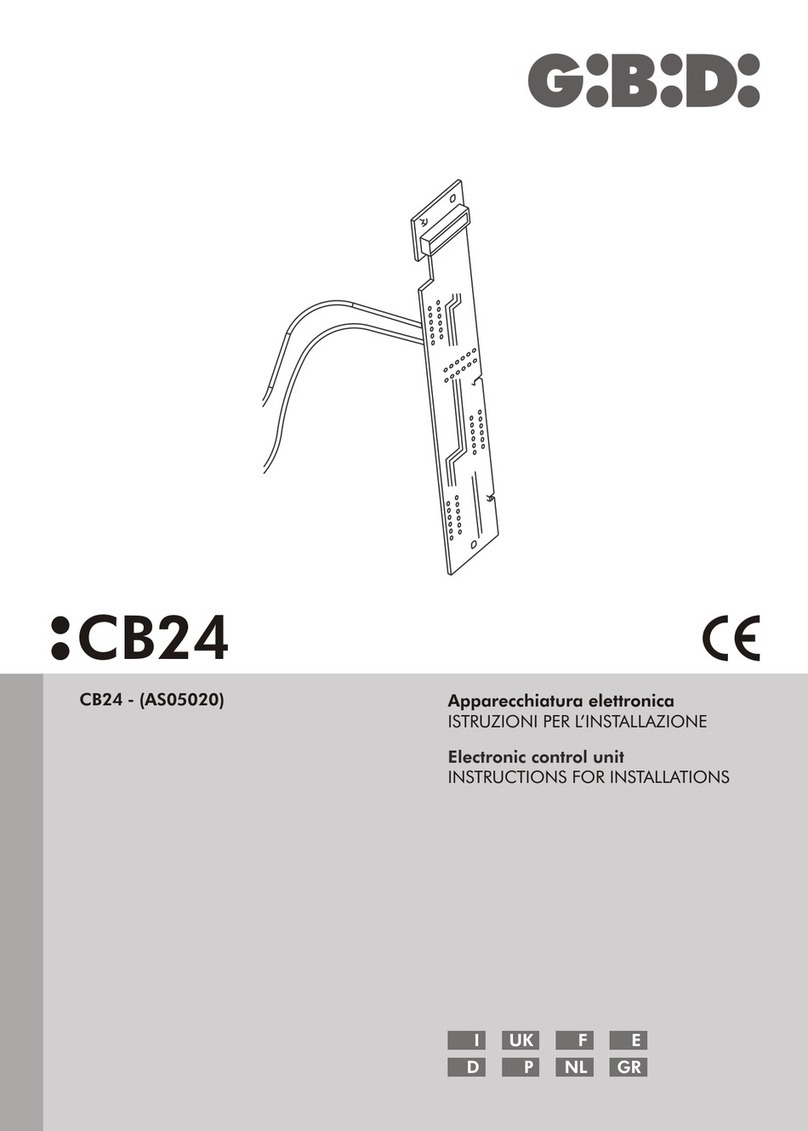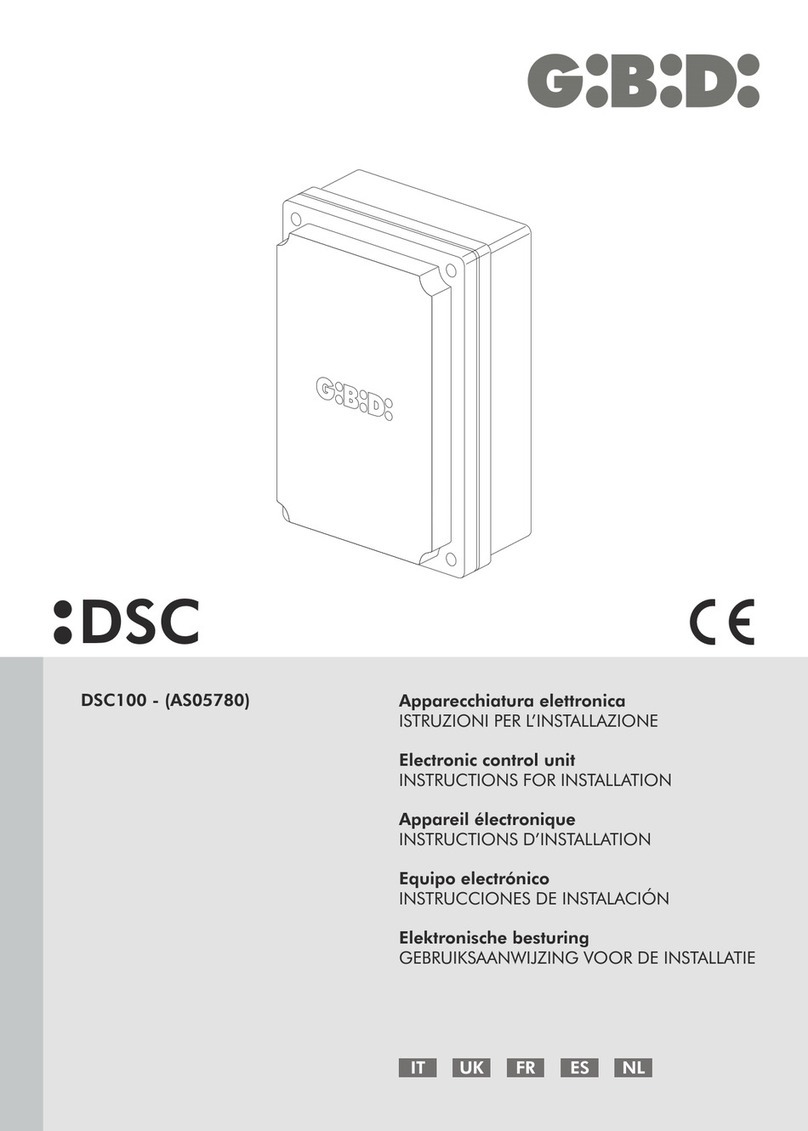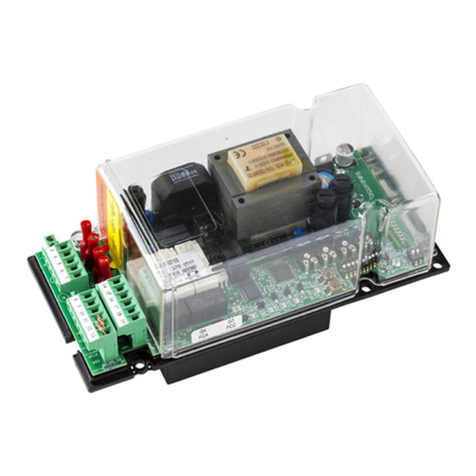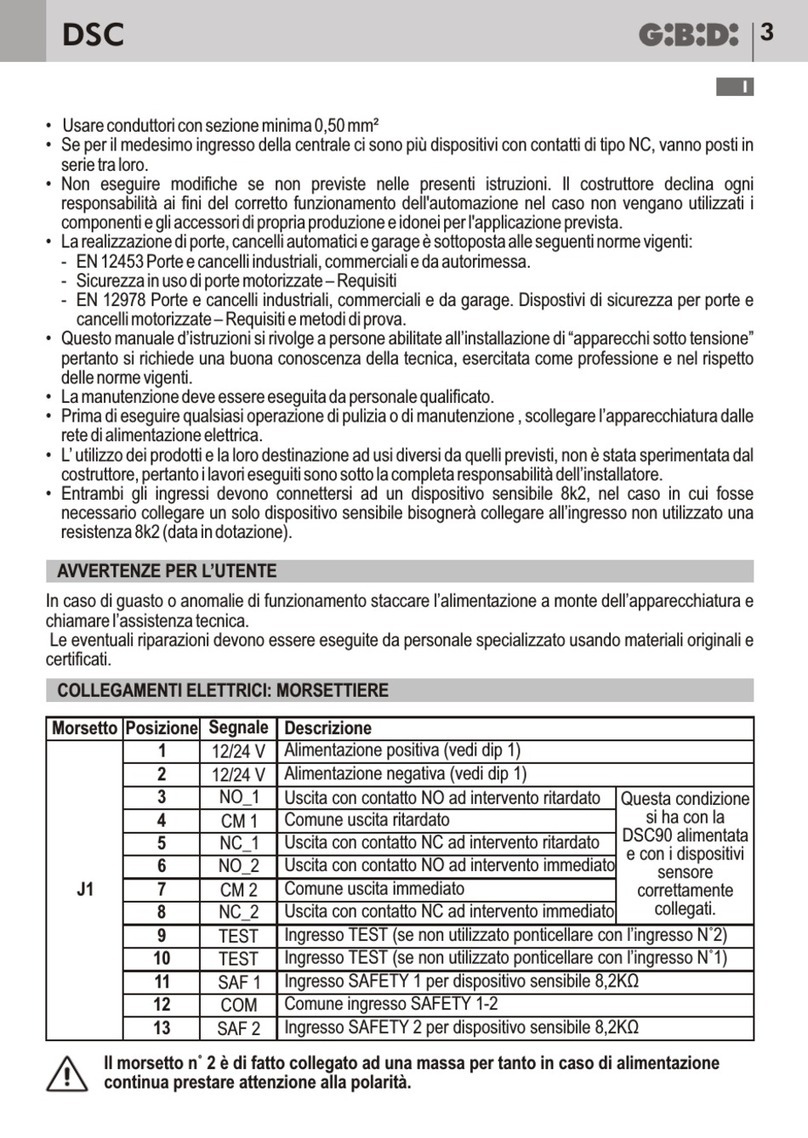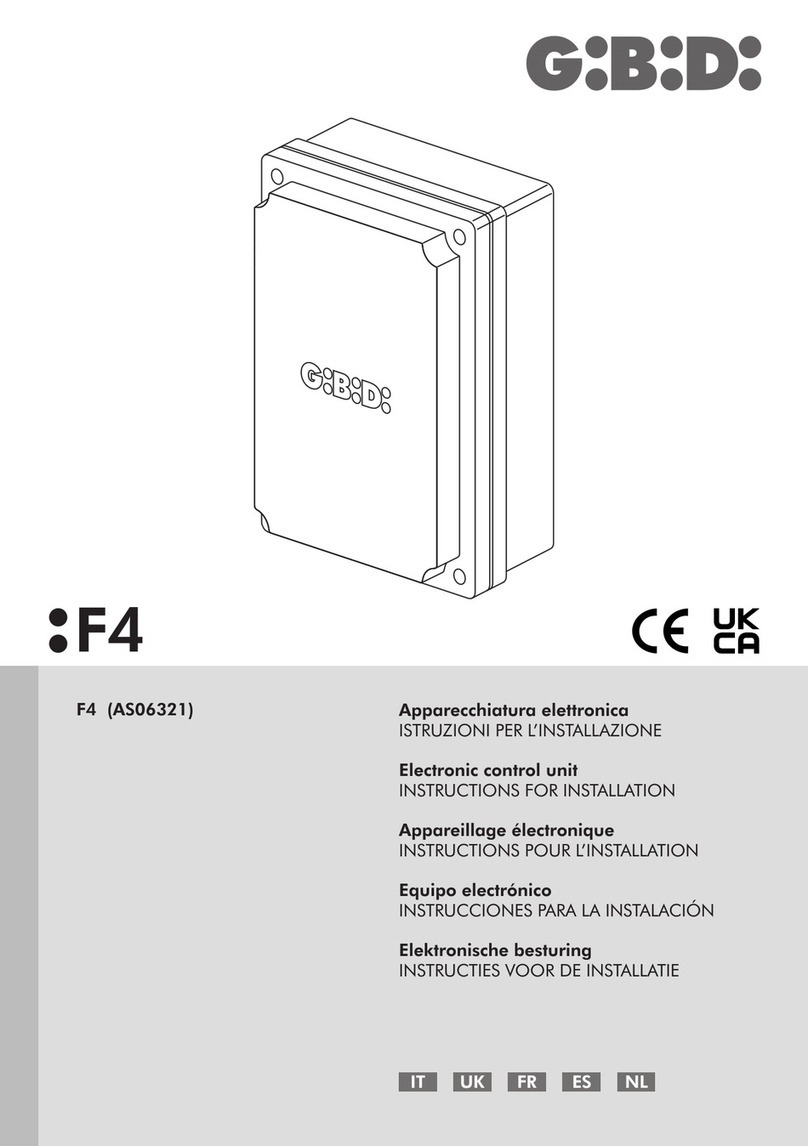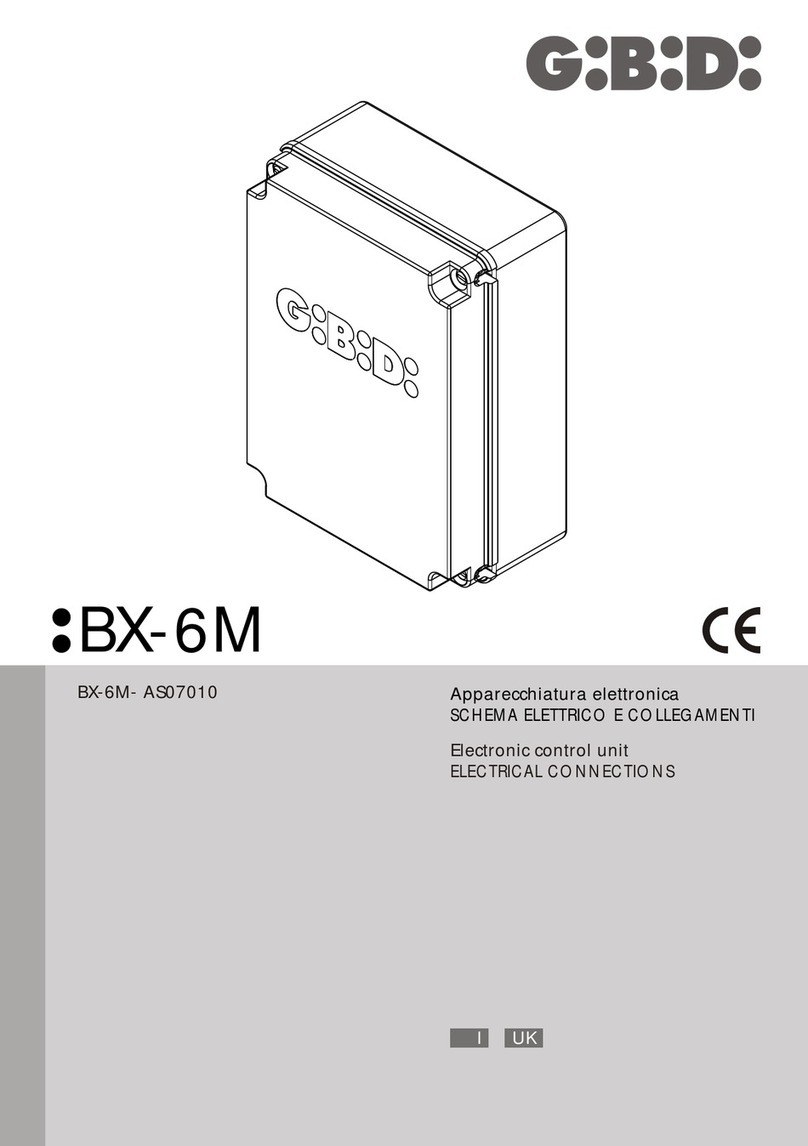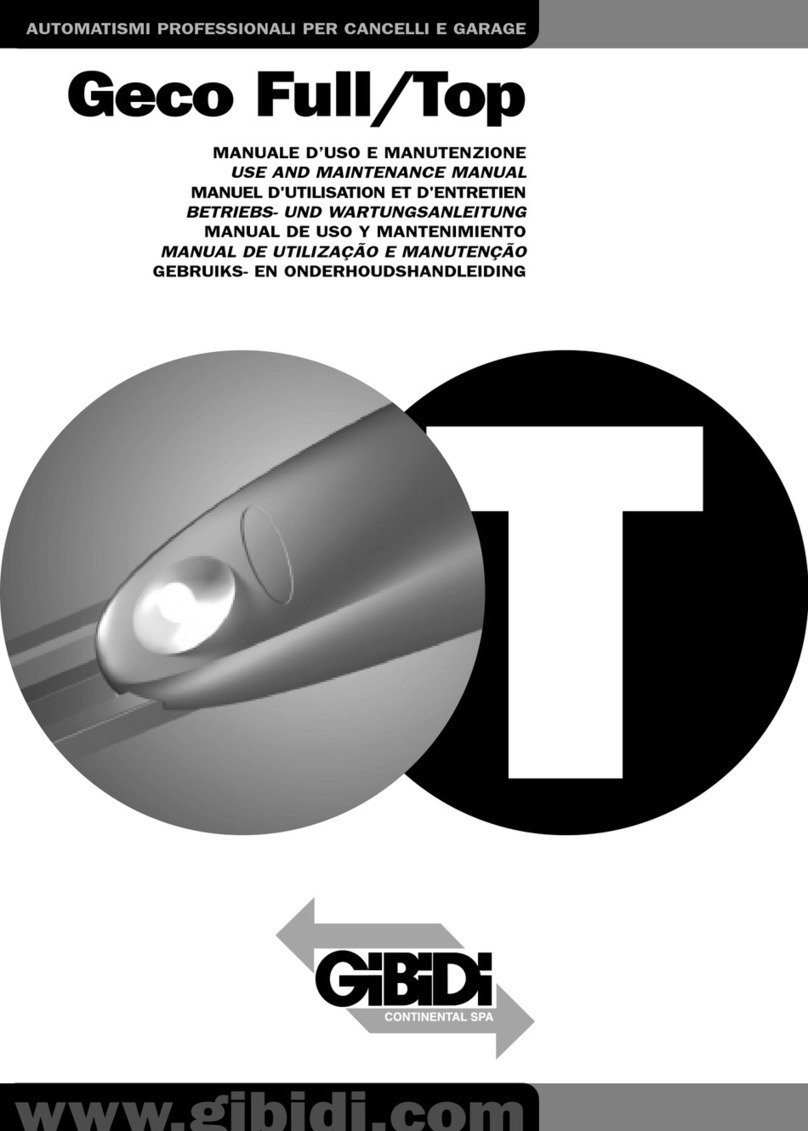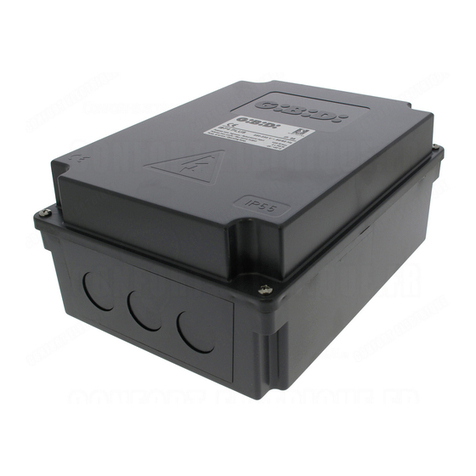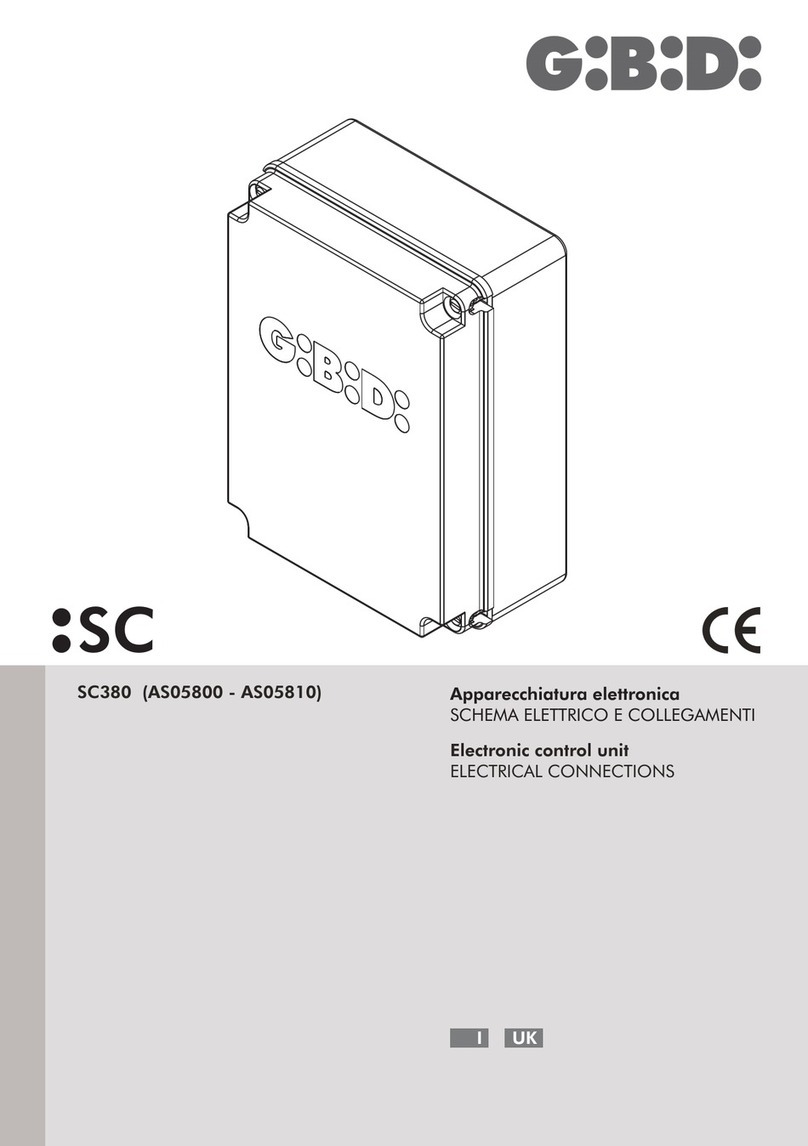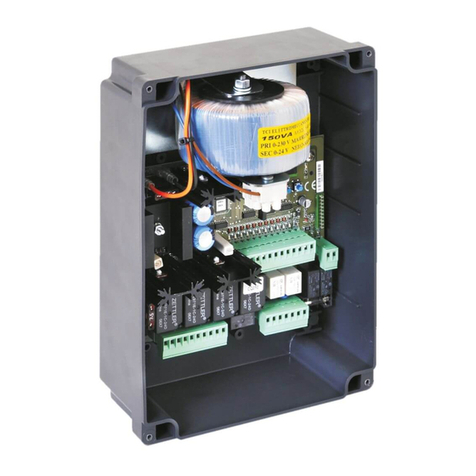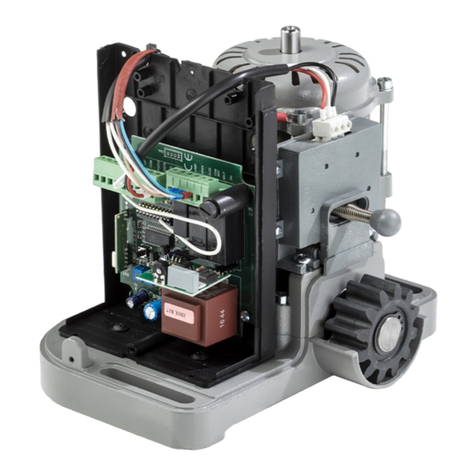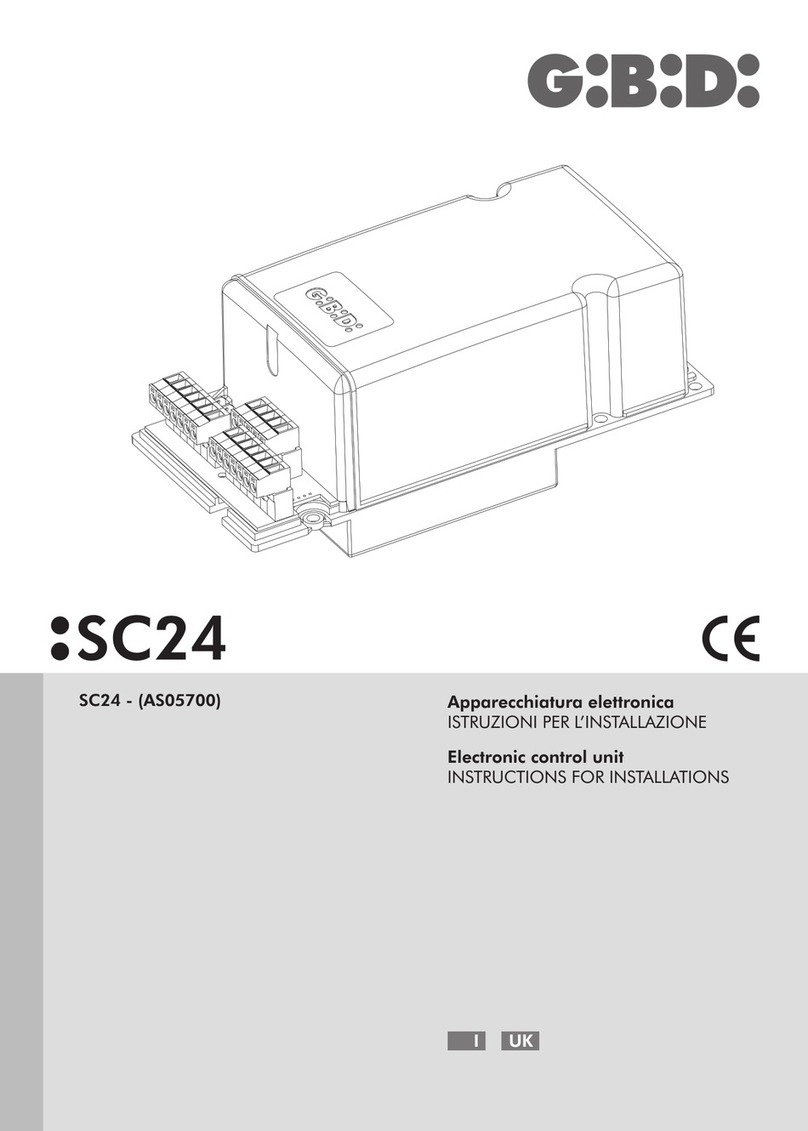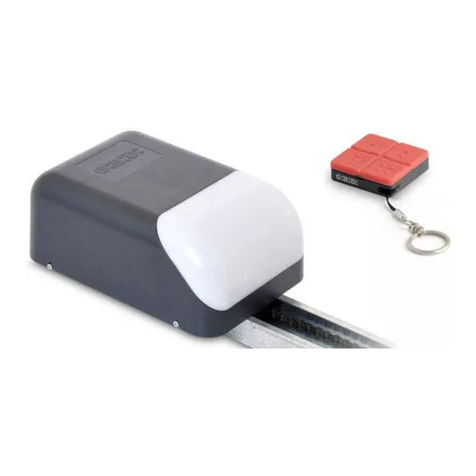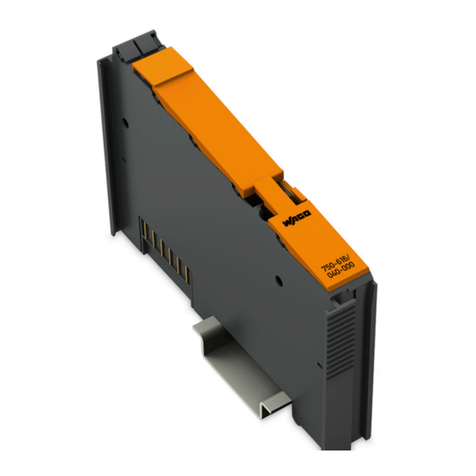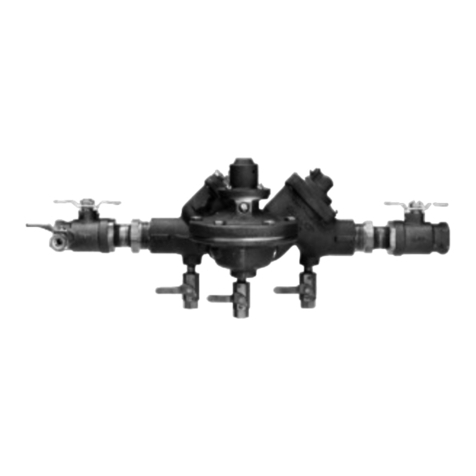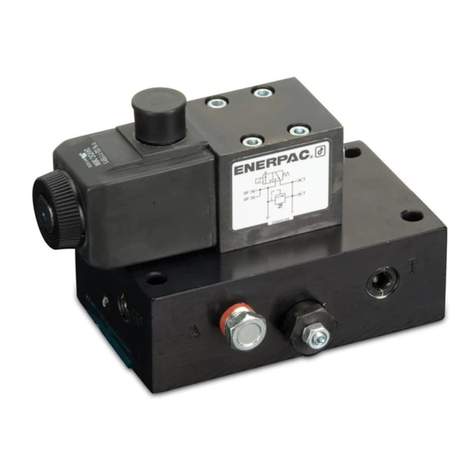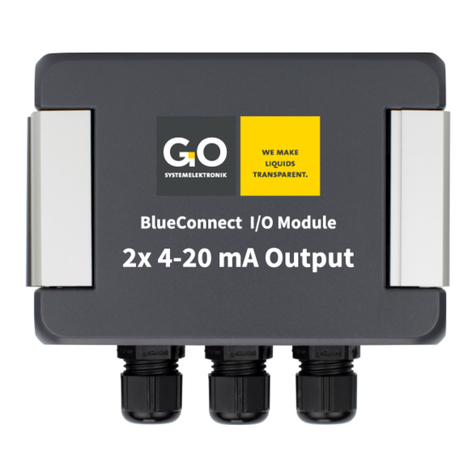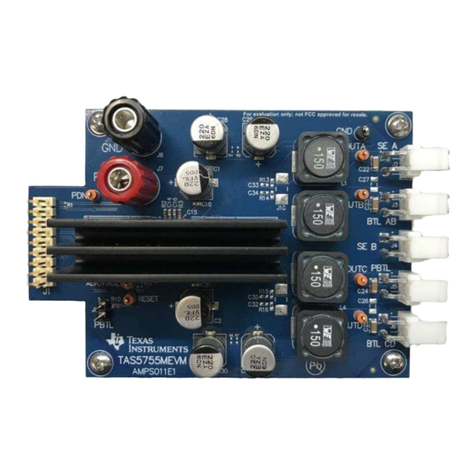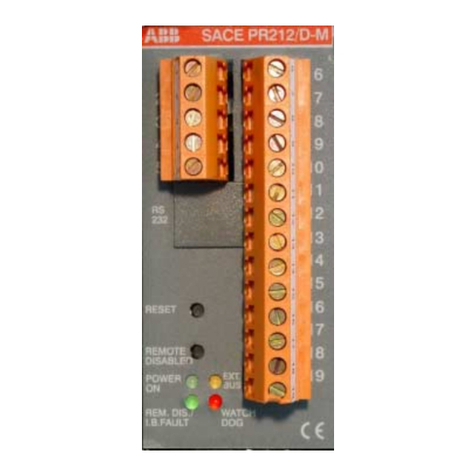GiBiDi SC24 Guide

SC24
RX
F2
F3
U2
8 9 10 11 12 13 14
22 23
GIBIDI
START
D3
0-VAC
18-VAC
M5
SW1
1 2 3 4 5 6 7 8 9
10
5A
MOTOR
OPEN
+SAFETY
COM
FCA
FCC
0VAC
LAMP
SPIA
COM
OPT
STOP
START
PED
PHOTO
SAFETY
COM
315mA
MOT
STOP (NC)
PHOTO (NC)
START (NO)
COMMON
FCC (NC)
FCA (NC)
ON
24-VAC
M2
M1
M3
15 16 17 18 19 20 21
1 2 3 4 5 6 7
24VAC
+ SK
- SK
+ACCES
MOTOR
CLOSE
GND
ANT
START PED (NO)
SAFETY (NC)
SCHEDA CARICABATTERIA
MOTOR
OPEN
+ SAFETY
FCA
FCC
M3
15 16 17 18 19 20 21
MOTOR
CLOSE
+ ACCES
COM
+ 24Vcc
+ 24Vcc
SAFETY.DEV
AMP.SLOW STOPOPT
D25 D14 D12 D7
PED
D1
PHOTOFCA
D10 D5
START
PED
F1
K2
K5 K4
K1
K3
SLOW PAUSE
AMP.
FORCE
Sw11
FCC
L1
24V MAX 10W
24V MAX 3W
1
2
3
MOTORE 24V
500mA
FORCE
SC24F
CARATTERISTICHE TECNICHE
•Led rossi di segnalazione dei contatti n.c
•Led verdi di segnalazione dei contatti n.a
•Test sicurezze effettuato prima del movimento di apertura e chiusura.
•Rallentamento in apertura e chiusura comandato da 2 magneti supplementari da assemblare nella posizione
desiderata, ad una distanza Il
rallentamento è regolabile con opportuno trimmer (SLOW).
•Arresto ed inversione del moto per 2 s dopo l'intervento dei dispositivi di sicurezza. Al successivo impulso di Start il
moto riparte nel senso di liberazione dell'ostacolo.
•Lettura amperometrica dell'assorbimento del motore per la funzione antischiacciamento, sia in funzionamento
normale che in modalità rallentata. (regolabile con opportuni trimmer AMP.FORCE e AMP.SLOW). L'intervento
amperometrico determina l'arresto e l'inversione del moto per 2 s. Al successivo impulso di Start il moto riparte nel
senso di liberazione dell'ostacolo.
•Funzionamento pedonale con apertura fissa di 10 s. Sono sempre abilitate la funzione condominiale e la richiusura
automatica.
•Predisposizione per uso con batterie a tampone (scheda accessoria caricabatteria cod. AJ00601)
•Verifica dello stato di carica delle batterie. Durante il funzionamento con le batterie verrà attivato un segnale
acustico sincronizzato con il lampeggiatore. Quando le batterie saranno prossime all'esaurimento, dopo un
comando di apertura il cancello si aprirà e quindi resterà aper to. Qualora le batterie non avessero una carica
sufficiente la porta non si aprirà.
•ALIMENTAZIONE DISPOSITIVI DI SICUREZZA. Il collegamento a questa alimentazione permetterà il TEST dei
dispositivi prima del moto. A questo morsetto vanno collegati i dispositivi di sicurezza che verranno alimentati solo
durante il ciclo di funzionamento.
. (photo, safety dev, fcc, fca, stop).
. (start, ped).
minima di almeno 400 mm rispetto a quelli utilizzati come finecorsa (Fig.2).
CARATTERISTICHE TECNICHE / FUNZIONI
SC24
I
Apparecchiatura SC24
Tipo
Apparecchiatura elettronica per l’automazione di un cancello
scorrevole con motore a 24Vcc
Alimentazione 230Vac monofase 50/60 Hz
N° motori 1
Alimentazione motore 24Vcc
Lampeggiante 24Vcc 10W max
Lampada spia 24Vcc 3W max
Alimentazione accessori 24Vcc 8W max comprensivi di alimentazione dispositivi di
sicurezza
Alimentazione dispositivi di sicurezza 24Vcc 8W max comprensivi di alimentazione accessori
Ricevitore radio Ad innesto
Temperatura di utilizzo -20°C +60°C
Tempo di lavoro 240 s fisso
Tempo di pausa Regolabile da 2 a 215 s
Tipo di batteria consigliata Batteria ricaricabile al piombo 24V 2Ah (2 x 12V 2Ah)
Fig.1Fig.1
SC242

Sede Legale :
Via B.Bonomi, 17 Fraz. Toline 25055 Pisogne (BS) ITALY
Sede Amministrativa
Ufficio Commerciale
Stabilimento:
46025 Poggio Rusco (Mantova) ITALY
Via Abetone Brennero, 177/B
Tel. 0039 0386 522011 r.a.
Fax Ufficio Commerciale 0039 0386 522031
ISO 9001 - Cert.n°0079
www.gibidi.comwww.gibidi.com
AIC7070 - 04/06 -REV00 GRAPHIC CENTER
AUTOMATISMI PROFESSIONALI PER CANCELLI E GARAGES - PROFESSIONAL AUTOMATIC DEVICES FOR GATES AND GARAGE DOORS
SC24
APPARECCHIATURA ELETTRONICA - ISTRUZIONI PER L’INSTALLAZIONE
ELECTRONIC CONTROL UNIT - INSTRUCTIONS FOR INSTALLATIONS
APPAREIL ÉLECTRONIQUE - INSTRUCTIONS POUR LE MONTAGE
EQUIPO ELECTRÓNICO - INSTRUCCIONES PARA EL MONTAJE
ELEKTRONIKGERÄT - INSTRUCTIEHANDLEIDING
EQUIPAMENTO ELECTRÓNICO - INSTRUÇÕES DE INSTALAÇÃO
ELEKTRONISCHE APPARATUUR - INSTALLATIONSANLEITUNG
LEGGERE ATTENTAMENTE QUESTO MANUALE PRIMA DI PROCEDERE ALL’INSTALLAZIONE.
I
•Questo prodotto è stato collaudato in Gi.Bi.Di. verificando la perfetta corrispondenza delle caratteristiche alle direttive
vigenti.
•La Gi.Bi.Di. Continental S.p.A. si riserva la facoltà di modificare i dati tecnici senza avviso, in funzione dell’evoluzione del
prodotto.
UK
•This product has been tested in Gi.Bi.Di. verifying the perfect correspondence of the characteristics to the cur rent
directive.
•Gi.Bi.Di. Continental S.p.A. reserves the right to modify the technical data without prior notice depending on the product
development.
PLEASE READ CAREFULLY THIS MANUAL BEFORE PROCEEDING WITH THE INSTALLATION.
F
•Ce produit a été essayé en Gi.Bi.Di. en vérifiant la correspondance parfaite des caractéristiques aux règles en vigueur.
•Gi.Bi.Di. Continental S.p.A. se réserve la faculté de modifier les données techniques sans aucun préavis suivant
l’évolution de ses produits.
S’IL VOUS PLAÎT DE LIRE AVEC ATTENTION CETTE MANUAL AVANT DE PROCÉDER AVEC L’INSTALATION.
E
•Este producto ha sido probado en Gi.Bi.Di. averiguando la perfecta correspondencia de las características a las normas
vigentes.
•La empresa Gi.Bi.Di. Continental S.p.A. se reserva el derecho de modificar los datos técnicos sin previo aviso, en
función de la evolución del producto.
POR FAVOR LEER CON ATENCIÓN ESTE MANUAL ANTES DE PROCEDER CON LA INSTALACIÓN.
D
•Dieses Produkt wurde in Gi.Bi.Di. geprüft um die perfekte Entsprechung der merkmäle an die geltende vorschrif ten zu
prüfen.
•Gi.Bi.Di. Continental S.p.A. behält sich das recht vor, die technischen daten der produktentwicklung entsprechend ohne
voranzeige abzuändern.
BITTE LESEN SIE VORSICHTIG DIESEN MANUAL BEVOR MIT DER ANGLAGE VORZUGEHEN.
P
•Este produto foi testado em Gi.Bi.Di. verificando a correspondência perfeita das características ao normas vigentes.
•A Gi.Bi.Di. Continental S.p.A. reserva-se o direito de modificar os dados técnicos sem pré-aviso em função de evolução
do produto.
LER COM ATENÇÃO ESTE MANUAL ANTES DE PROCEDER COM A INSTALAÇÃO.
NL
•Dit product werd gekeurd in Gi.Bi.Di. Er werd nauwlettend gecontroleerd of de kenmerken van het product perfect
overeenkomen met de geldige richtlijnen.
•Gi.Bi.Di. Continental S.p.A. behoudt zich het recht voor de technische gegevens te wijzigen zonder waarschuwing vooraf,
als dat nodig is voor de evolutie van het product.
LEES DEZE GEBRUIKSAANWIJZING ZEER AANDACHTIG ALVORENS DE INSTALLATIE AAN TE VATTEN.

In caso di guasto o anomalie di funzionamento staccare l’alimentazione a monte dell’apparecchiaura e chiamare
l’assistenza tecnica.
Verificare periodicamente il funzionamento delle sicurezze. Le eventuali riparazioni devono essere eseguite da
personale specializzato usando materiali originali e certificati.
AVVERTENZE PER L’UTENTE
•Prima di procedere con l’installazione bisogna predisporre a monte dell’impianto un interruttore magneto
termico o differenziale con portata massima 10A. L’interruttore deve garantire una separazione omnipolare dei
contatti, con distanza di apertura di almeno 3 mm.
•Per evitare possibili interferenze, differenziare e tenere sempre separati i cavi di potenza (sezione minima
1,5mm²) dai cavi di segnale (sezione minima 0,5mm²).
•Eseguire i collegamenti facendo riferimento alle tabelle seguenti e alla serigrafia allegata. Fare molta attenzione
a collegare in serie tutti i dispositivi che vanno collegati allo stesso ingresso N.C. (normalmente chiuso) e in
parallelo tutti i dispositivi che condividono lo stesso ingresso N.A. (normalmente aperto). Una errata
installazione o un uso errato del prodotto può compromettere la sicurezza dell’impianto.
•Tutti i materiali presenti nell’imballo non devono essere lasciati alla portata dei bambini in quanto potenziali
fonti di pericolo.
•Il costruttore declina ogni responsabilità ai fini del corretto funzionamento dell'automazione nel caso non
vengano utilizzati i componenti e gli accessori di propria produzione e idonei per l'applicazione prevista.
•Al termine dell’istallazione verificare sempre con attenzione il corretto funzionamento dell’impianto e dei
dispositivi utilizzati.
•Questo manuale d’istruzioni si rivolge a persone abilitate all’installazione di “apparecchi sotto tensione”
pertanto si richiede una buona conoscenza della tecnica, esercitata come professione e nel rispetto delle norme
vigenti.
•La manutenzione deve essere eseguita da personale qualificato.
•Prima di eseguire qualsiasi operazione di pulizia o di manutenzione scollegare l’apparecchiatura dalle rete di
alimentazione elettrica.
•L’apparecchiatura qui descritta deve essere utilizzata solo all’uso per il quale è stata concepita: la
motorizzazione di un cancello scorrevole a 24Vcc, lunghezza max 3m - peso max 350 kg.
•L’ utilizzo dei prodotti e la loro destinazione ad usi diversi da quelli previsti non è stata sperimentata dal
costruttore, pertanto i lavori eseguiti sono sotto la completa responsabilità dell’installatore.
•Segnalare l’automazione con targhe di avvertenza che devono essere visibili.
•Avvisare l’utente che bambini o animali non devono giocare o sostare nei pressi del cancello.
•Proteggere adeguatamente i punti di pericolo (per esempio mediante l’uso di una costa sensibile).
AVVERTENZE PER L’INSTALLAZIONE
I
LA FUNZIONE ANTI-SCHIACCIAMENTO NON ELIMINA L’OBBLIGO DI INSTALLARE I
DISPOSITIVI DI SICUREZZA PREVISTI DALLE NORMATIVE VIGENTI.
SC24 3

PROGRAMMAZIONE FUNZIONI (DIP SWITCH-Sw1)
I
I
SC244 SC24 5
COLLEGAMENTI ELETTRICI: FASTON
COLLEGAMENTI ELETTRICI: MORSETTIERE
Posizione Segnale Descrizione
1 0 Vac COLLEGAMENTO 0Vac TRASFORMATORE (CAVO NERO).
2 18 Vac COLLEGAMENTO 18Vac TRASFORMATORE (CAVO ARANCIONE).
3 24 Vac COLLEGAMENTO 24Vac TRASFORMATORE (CAVO ROSSO).
Le impostazioni vengono memorizzate durante la fase di riposo (cancello chiuso).
Morsetto Posizione Segnale Descrizione
1 0 Vac Uscita 0Vac alla SCHEDA CARICABATTERIA.
2 + 24 Vac Uscita 24 Vac alla SCHEDA CARICABATTERIA.
3 +SK BAT COLLEGAMENTO positivo alla SCHEDA CARICABATTERIA.
4 -SK BAT COLLEGAMENTO negativo alla SCHEDA CARICABATTERIA.
5 LAMP Uscita lampeggiatore 24V 10W max (lampeggio lento in apertura, spento con cancello aperto, lampeggio veloce in
chiusura); può essere collegato anche alla SCHEDA CARICABATTERIA.
6 SPIA Uscita Lampada spia 24V 3W max (lampeggio lento in apertura, accesa fissa con cancello aperto, lampeggio veloce
in chiusura).
M1
7 COM COMUNE INGRESSI-USCITE.
8 OPT NON USATO.
9 STOP Ingresso STOP (N.C.).Se non utilizzato ponticellare con morsetto n°14.
10 START Ingresso START (N.A.).
11 PED Ingresso PEDONALE (N.A.).
12 PHOTO Ingresso FOTOCELLULA (N.C.). Se non utilizzato ponticellare con morsetto n°14.
13 SAFETY Ingresso DISPOSITIVI DI SICUREZZA (N.C.). Se non utilizzato ponticellare con morsetto n°14 e porre DIP 4 in OFF.
M2
14 COM COMUNE INGRESSI-USCITE.
15 MOTOR OPEN Uscita motore 24V apre.
16 MOTOR CLOSE Uscita motore 24 V chiude.
17 + ACCES Alimentazione +24Vcc accessori esterni (fotocellule, radio, etc).
18 + SAFETY Alimentazione +24Vcc dispositivi di sicurezza esterni (costa) presente solo durante il ciclo di funzionamento, collegare
a questo ingresso i dispositivi sui quali si desidera effettuare il test di sicurezza (vedi anche DIP n°4).
19 COM COMUNE INGRESSI-USCITE.
20 FCA Ingresso finecorsa apertura
M3
21 FCC Ingresso finecorsa chiusura N.B. non collegare se la scheda è assemblata sull’operatore.
22 GND Ingresso CALZA ANTENNA.
M5 23 ANT Ingresso SEGNALE ANTENNA.
DIP STATO Funzione Descrizione
DIP 1
DIP 2
OFF
OFF PASSO – PASSO CON STOP
I impulso di Start :APRE
II impulso di Start :ARRESTA (non richiuderà in automatico)
III impulso di Start :CHIUDE
IV impulso di Start :APRE
DIP 1
DIP 2
ON
OFF PASSO - PASSO
I impulso di Start :APRE
II impulso di Start :CHIUDE
III impulso di Start :APRE
DIP 1
DIP 2
OFF
ON CONDOMINIALE
In apertura non riceve altri comandi di Star t dopo il primo, in pausa successivi coman di di
Start ricaricano il tempo di pausa.
I impulso di Start :APRE
Successivi impulsi di Start :Ininfluenti
Pausa da FCA
Impulso di Start durante la pausa :Ricarica il tempo pausa (se dip 6 ON)
(se dip 6 OF F).
Successivo impulso di Start :APRE
DIP 1
DIP 2
ON
ON UOMO PRESENTE Se mantenuto premuto pulsante Start :APRE
Se mantenuto premuto pulsante Pedonale :CHIUDE
DIP 3 ON Abilita il prelampeggio di 2 s prima dell’attivazione del motore in apertura e chiusura.
DIP3 OFF PRELAMPEGGIO Disabilita il prelampeggio.
DIP 4 ON
Abilita il TEST dei dispositivi di sicurezza prima di attivare il ciclo di aper tura e chiusura.
Il TEST consiste nel togliere momentaneamente alimentazione ai dispositivi (morsetto 18
corretta commutazione del contatto (morsetto 13 SAFETY).
Solo se i dispositivi saranno per fettamente funzionanti il ciclo potrà iniziare, in caso
contrario tre lampeggi prolungati indicheranno l’anomalia.
DIP 4 OFF
TEST SICUREZZE
Disabilita il test dei dispositivi di sicurezza.
DIP 5 ON
Quando viene intercettata la fotocellula, sia in apertura che in chiusura, viene bloccato il
moto del cancello fintanto che la fotocellula stessa non viene liberata. Successivamente si
ha sempre una fase di apertura.
DIP 5 OFF
FOTOCELLULA IN APERTURA
Disabilita la funzione fotocellula in apertura.
DIP 6 ON Abilita la chiusura automatica dopo il tempo di pausa regolabile tramite il trimmer TR5
PAUSE da 2 a 215 s.
DIP 6 OFF
RICHIUSURA AUTOMATICA
Disabilita la chiusura automatica.
DIP 7 ON
Abilita il rallentamento sia in aper tura che in chiusura quando viene intercettato il rispettivo
fine corsa. La velocità di rallentamento è regolata dal trimmer TR3 SLOW. Questa funzione
prevede l’impiego di 4 magneti (vedere disegno 2).
DIP 7 OFF
RALLENTAMENTO
Disabilita la funzione rallentamento. Necessaria la presenza di 2soli magneti (vedere
disegno 2).
DIP 8 ON Riduce il tempo di pausa a 3 s dopo l’intervento di una delle fotocellule.
DIP 8 OFF RICHIUSURA RAPIDA Disabilita la funzione di richiusura rapida.
DIP 9 ON Non usato.
DIP 9 OFF Non usato.
DIP 10 ON
Alimenta i led (che quindi si accenderanno in funzione del rispettivo contatto).
Dopo aver effettuato la corretta installazione è possibile disattivare l’alimentazione dei led
per il risparmio energetico.
DIP 10 OFF
ALIMENTAZIONE LED
Disabilita l’alimentazione dei led di segnalazione.
oppure CHIUDE
+SAFETY) verificando la
FUSIBILI DI PROTEZIONE
Posizione Valore Tipo Descrizione
F1 315 mA RAPIDO Protegge le uscite di alimentazione ACCESSORI e DISPOSITIVI di SICUREZZA.
F2 5A RAPIDO Protegge l’apparecchiatura all’ingresso alimentazione 24 Vac.
F3 500 mA RAPIDO Protegge l’uscita del lampeggiatore.

PROGRAMMAZIONE FUNZIONI (DIP SWITCH-Sw1)
I
I
SC244 SC24 5
COLLEGAMENTI ELETTRICI: FASTON
COLLEGAMENTI ELETTRICI: MORSETTIERE
Posizione Segnale Descrizione
1 0 Vac COLLEGAMENTO 0Vac TRASFORMATORE (CAVO NERO).
2 18 Vac COLLEGAMENTO 18Vac TRASFORMATORE (CAVO ARANCIONE).
3 24 Vac COLLEGAMENTO 24Vac TRASFORMATORE (CAVO ROSSO).
Le impostazioni vengono memorizzate durante la fase di riposo (cancello chiuso).
Morsetto Posizione Segnale Descrizione
1 0 Vac Uscita 0Vac alla SCHEDA CARICABATTERIA.
2 + 24 Vac Uscita 24 Vac alla SCHEDA CARICABATTERIA.
3 +SK BAT COLLEGAMENTO positivo alla SCHEDA CARICABATTERIA.
4 -SK BAT COLLEGAMENTO negativo alla SCHEDA CARICABATTERIA.
5 LAMP Uscita lampeggiatore 24V 10W max (lampeggio lento in apertura, spento con cancello aperto, lampeggio veloce in
chiusura); può essere collegato anche alla SCHEDA CARICABATTERIA.
6 SPIA Uscita Lampada spia 24V 3W max (lampeggio lento in apertura, accesa fissa con cancello aperto, lampeggio veloce
in chiusura).
M1
7 COM COMUNE INGRESSI-USCITE.
8 OPT NON USATO.
9 STOP Ingresso STOP (N.C.).Se non utilizzato ponticellare con morsetto n°14.
10 START Ingresso START (N.A.).
11 PED Ingresso PEDONALE (N.A.).
12 PHOTO Ingresso FOTOCELLULA (N.C.). Se non utilizzato ponticellare con morsetto n°14.
13 SAFETY Ingresso DISPOSITIVI DI SICUREZZA (N.C.). Se non utilizzato ponticellare con morsetto n°14 e porre DIP 4 in OFF.
M2
14 COM COMUNE INGRESSI-USCITE.
15 MOTOR OPEN Uscita motore 24V apre.
16 MOTOR CLOSE Uscita motore 24 V chiude.
17 + ACCES Alimentazione +24Vcc accessori esterni (fotocellule, radio, etc).
18 + SAFETY Alimentazione +24Vcc dispositivi di sicurezza esterni (costa) presente solo durante il ciclo di funzionamento, collegare
a questo ingresso i dispositivi sui quali si desidera effettuare il test di sicurezza (vedi anche DIP n°4).
19 COM COMUNE INGRESSI-USCITE.
20 FCA Ingresso finecorsa apertura
M3
21 FCC Ingresso finecorsa chiusura N.B. non collegare se la scheda è assemblata sull’operatore.
22 GND Ingresso CALZA ANTENNA.
M5 23 ANT Ingresso SEGNALE ANTENNA.
DIP STATO Funzione Descrizione
DIP 1
DIP 2
OFF
OFF PASSO – PASSO CON STOP
I impulso di Start :APRE
II impulso di Start :ARRESTA (non richiuderà in automatico)
III impulso di Start :CHIUDE
IV impulso di Start :APRE
DIP 1
DIP 2
ON
OFF PASSO - PASSO
I impulso di Start :APRE
II impulso di Start :CHIUDE
III impulso di Start :APRE
DIP 1
DIP 2
OFF
ON CONDOMINIALE
In apertura non riceve altri comandi di Star t dopo il primo, in pausa successivi coman di di
Start ricaricano il tempo di pausa.
I impulso di Start :APRE
Successivi impulsi di Start :Ininfluenti
Pausa da FCA
Impulso di Start durante la pausa :Ricarica il tempo pausa (se dip 6 ON)
(se dip 6 OF F).
Successivo impulso di Start :APRE
DIP 1
DIP 2
ON
ON UOMO PRESENTE Se mantenuto premuto pulsante Start :APRE
Se mantenuto premuto pulsante Pedonale :CHIUDE
DIP 3 ON Abilita il prelampeggio di 2 s prima dell’attivazione del motore in apertura e chiusura.
DIP3 OFF PRELAMPEGGIO Disabilita il prelampeggio.
DIP 4 ON
Abilita il TEST dei dispositivi di sicurezza prima di attivare il ciclo di aper tura e chiusura.
Il TEST consiste nel togliere momentaneamente alimentazione ai dispositivi (morsetto 18
corretta commutazione del contatto (morsetto 13 SAFETY).
Solo se i dispositivi saranno per fettamente funzionanti il ciclo potrà iniziare, in caso
contrario tre lampeggi prolungati indicheranno l’anomalia.
DIP 4 OFF
TEST SICUREZZE
Disabilita il test dei dispositivi di sicurezza.
DIP 5 ON
Quando viene intercettata la fotocellula, sia in apertura che in chiusura, viene bloccato il
moto del cancello fintanto che la fotocellula stessa non viene liberata. Successivamente si
ha sempre una fase di apertura.
DIP 5 OFF
FOTOCELLULA IN APERTURA
Disabilita la funzione fotocellula in apertura.
DIP 6 ON Abilita la chiusura automatica dopo il tempo di pausa regolabile tramite il trimmer TR5
PAUSE da 2 a 215 s.
DIP 6 OFF
RICHIUSURA AUTOMATICA
Disabilita la chiusura automatica.
DIP 7 ON
Abilita il rallentamento sia in aper tura che in chiusura quando viene intercettato il rispettivo
fine corsa. La velocità di rallentamento è regolata dal trimmer TR3 SLOW. Questa funzione
prevede l’impiego di 4 magneti (vedere disegno 2).
DIP 7 OFF
RALLENTAMENTO
Disabilita la funzione rallentamento. Necessaria la presenza di 2soli magneti (vedere
disegno 2).
DIP 8 ON Riduce il tempo di pausa a 3 s dopo l’intervento di una delle fotocellule.
DIP 8 OFF RICHIUSURA RAPIDA Disabilita la funzione di richiusura rapida.
DIP 9 ON Non usato.
DIP 9 OFF Non usato.
DIP 10 ON
Alimenta i led (che quindi si accenderanno in funzione del rispettivo contatto).
Dopo aver effettuato la corretta installazione è possibile disattivare l’alimentazione dei led
per il risparmio energetico.
DIP 10 OFF
ALIMENTAZIONE LED
Disabilita l’alimentazione dei led di segnalazione.
oppure CHIUDE
+SAFETY) verificando la
FUSIBILI DI PROTEZIONE
Posizione Valore Tipo Descrizione
F1 315 mA RAPIDO Protegge le uscite di alimentazione ACCESSORI e DISPOSITIVI di SICUREZZA.
F2 5A RAPIDO Protegge l’apparecchiatura all’ingresso alimentazione 24 Vac.
F3 500 mA RAPIDO Protegge l’uscita del lampeggiatore.

VERIFICHE FINALI E COLLAUDO
!DIP 1 E DIP 2 entrambi OFF: Passo passo con stop
!DIP 3 OFF: Prelampeggio escluso
!DIP 4 OFF: Test dispositivi di sicurezza escluso
!DIP 5 OFF: Fotocellula in apertura esclusa
!DIP 6 ON: Chiusura automatica abilitata
!DIP 7 OFF: Rallentamenti esclusi
!DIP 8 OFF: Richiusura rapida esclusa
!DIP 9 OFF: Ininfluente
!DIP 10 ON: Led alimentati
IMPOSTAZIONI DI DEFAULT
REGOLAZIONE TRIMMER
!
!
I trimmer TR1, TR2, TR3, TR4 possono essere regolati anche durante il movimento del cancello,
verificando così immediatamente l'effetto.
Il trimmer TR5 viene memorizzato solo durante la fase di riposo (cancello chiuso).
!TRIMMER TR1 TR3 TR5 regolati al minimo
!TRIMMER TR2 TR4 regolati al massimo
I
I
SC246 SC24 7
FC chiusura
Fermo motore
FC rallentamento
in chiusura
FC rallentamento
in apertura
FC apertura
Fermo motore
400 500mm Fig.2Fig.2
Trimmer Funzione Descrizione
TR1 FORCE Regola il livello della FORZA motore. La forza aumenta ruotando in senso orario il trimmer.
TR2 AMP.FORCE
Regola la soglia di intervento della funzione antischiacciamento durante il motonon rallentato. Il suo intervento
bloccherà e invertirà il moto per 2s al fine di liberare l’ostacolo. La soglia di intervento cresce ruotando in senso orario
il trimmer.
TR3 SLOW
Regola il livello del RALLENTAMENTO. Il rallentamento diminuisce ruotando in senso orario il trimmer. (in senso orario
si ha una maggiore velocità/forza del cancello).
TR4 AMP. SLOW
Regola la soglia di intervento della funzione antischiacciamento durante il moto rallentato. Il suo intervento bloccherà il
moto e invertirà per 2 s al fine di liberare l’ostacolo. La soglia di intervento cresce ruotando in senso orario il trim mer.
TR5 PAUSE Regola il TEMPO di PAUSA da 2 a 215 s. Il valore aumenta ruotando in senso orario il trimmer.
Prima di dare tensione all'apparecchiatura occorre procedere alle seguenti verifiche:
1 Verificare che la tensione e la frequenza riportate nelle caratteristiche tecniche corrispondano a quelle
dell’impianto di alimentazione.
2 Verificare l'impostazione corretta dei DIP, secondo le esigenze.
3 Regolare il trimmer TR5 (PAUSE) impostando
ALIMENTARE IL DISPOSITIVO
N.B.: Vicino ai faston di alimentazione (Fig.1) è presente un ponticello denominato SW11 che serve
all'installatore per alimentare i
venire i fine corsa utilizza
14 Se attivata la funzione rallentamento ruotare il trimmer TR4 (AMP.SLOW) in senso antiorario fino a
trovare il corretto valore della soglia amperometrica durante il moto rallentato (Fig.1)
N.B.:In caso di
il tempo di pausa desiderato (al max in senso
orario si ottengono 215 s)
4 Verificare i collegamenti elettrici: un collegamento errato può risultare dannoso sia per l'apparecchiatura
che per l'operatore.
5 Verificare la corretta posizione dei finecorsa (Fig.2). Fare attenzione alla corretta disposizione dei
magneti.
dispositivi di sicurezza (posizione 1-2) anche con cancello a riposo (normalmente
l'alimentazione dei dispositivi di sicurezza si ha solo durante il ciclo di apertura-pausa-chiusura) e fare i relativi
controlli.
Ricordarsi di posizionare il ponticello nella posizione 2-3 prima di attivare il normale funzionamento, altrimenti
con l'uso del TEST SICUREZZE verrà segnalato un'anomalia e il cancello resterà bloccato.
6 Verificare che i led rossi dei contatti N.C. siano accesi ed i led verdi dei contatti N.A. siano spenti
7 Verificare che facendo inter ti si spengano i led corrispondenti.
8 Verificare che passando attraversando il raggio delle fotocellule il led corrispondente si spenga.
9 Verificare che facendo intervenire i dispositivi di sicurezza il led corrispondente si spenga.
10 Verificare che il motore sia bloccato e pronto per il funzionamento in posizione di CANCELLO A META'
CORSA. Rimuovere eventuali ostacoli nel raggio d'azione del cancello quindi dare un comando di
START. Al primo comando l'apparecchiatura comincia una fase di apertura, quindi verificare che la
direzione del moto del cancello sia corretta. In caso contrario invertire i fili nei morsetti MOTOR OPEN
MOTOR CLOSE. Alla prima manovra il cancello si fermerà sul primo fine corsa di apertura che incontra.
Completare la manovra di chiusura per consentire all'apparecchiatura di leggere tutti i fine corsa presenti
ed allineare il cancello.
11 Ruotare il trimmer TR1 (FORCE) in senso orario fino a trovare il valore forza/velocità desiderato.(Fig.1).
12 Se attivata la funzione rallentamento ruotare il trimmer TR3 (SLOW) in senso orario fino a trovare il valore di
rallentamento desiderato. (Fig.1).
13 Ruotare il trimmer TR2 (AMP.FORCE) in senso antiorario fino a trovare il corretto valore della soglia
amperometrica durante il moto a forza piena (Fig.1).
disturbi elettrici o elettromagnetici ambientali, il cancello potrebbe fermarsi sul fine corsa
previsto per il rallentamento, al fine di impedire l'intervento dell'antischiacciamento contro il fermo meccanico.
Per ripristinare il corretto funzionamento effettuare una manovra completa di apertura e/o chiusura.
IMPOSTAZIONI DI DEFAULT

VERIFICHE FINALI E COLLAUDO
!DIP 1 E DIP 2 entrambi OFF: Passo passo con stop
!DIP 3 OFF: Prelampeggio escluso
!DIP 4 OFF: Test dispositivi di sicurezza escluso
!DIP 5 OFF: Fotocellula in apertura esclusa
!DIP 6 ON: Chiusura automatica abilitata
!DIP 7 OFF: Rallentamenti esclusi
!DIP 8 OFF: Richiusura rapida esclusa
!DIP 9 OFF: Ininfluente
!DIP 10 ON: Led alimentati
IMPOSTAZIONI DI DEFAULT
REGOLAZIONE TRIMMER
!
!
I trimmer TR1, TR2, TR3, TR4 possono essere regolati anche durante il movimento del cancello,
verificando così immediatamente l'effetto.
Il trimmer TR5 viene memorizzato solo durante la fase di riposo (cancello chiuso).
!TRIMMER TR1 TR3 TR5 regolati al minimo
!TRIMMER TR2 TR4 regolati al massimo
I
I
SC246 SC24 7
FC chiusura
Fermo motore
FC rallentamento
in chiusura
FC rallentamento
in apertura
FC apertura
Fermo motore
400 500mm Fig.2Fig.2
Trimmer Funzione Descrizione
TR1 FORCE Regola il livello della FORZA motore. La forza aumenta ruotando in senso orario il trimmer.
TR2 AMP.FORCE
Regola la soglia di intervento della funzione antischiacciamento durante il motonon rallentato. Il suo intervento
bloccherà e invertirà il moto per 2s al fine di liberare l’ostacolo. La soglia di intervento cresce ruotando in senso orario
il trimmer.
TR3 SLOW
Regola il livello del RALLENTAMENTO. Il rallentamento diminuisce ruotando in senso orario il trimmer. (in senso orario
si ha una maggiore velocità/forza del cancello).
TR4 AMP. SLOW
Regola la soglia di intervento della funzione antischiacciamento durante il moto rallentato. Il suo intervento bloccherà il
moto e invertirà per 2 s al fine di liberare l’ostacolo. La soglia di intervento cresce ruotando in senso orario il trim mer.
TR5 PAUSE Regola il TEMPO di PAUSA da 2 a 215 s. Il valore aumenta ruotando in senso orario il trimmer.
Prima di dare tensione all'apparecchiatura occorre procedere alle seguenti verifiche:
1 Verificare che la tensione e la frequenza riportate nelle caratteristiche tecniche corrispondano a quelle
dell’impianto di alimentazione.
2 Verificare l'impostazione corretta dei DIP, secondo le esigenze.
3 Regolare il trimmer TR5 (PAUSE) impostando
ALIMENTARE IL DISPOSITIVO
N.B.: Vicino ai faston di alimentazione (Fig.1) è presente un ponticello denominato SW11 che serve
all'installatore per alimentare i
venire i fine corsa utilizza
14 Se attivata la funzione rallentamento ruotare il trimmer TR4 (AMP.SLOW) in senso antiorario fino a
trovare il corretto valore della soglia amperometrica durante il moto rallentato (Fig.1)
N.B.:In caso di
il tempo di pausa desiderato (al max in senso
orario si ottengono 215 s)
4 Verificare i collegamenti elettrici: un collegamento errato può risultare dannoso sia per l'apparecchiatura
che per l'operatore.
5 Verificare la corretta posizione dei finecorsa (Fig.2). Fare attenzione alla corretta disposizione dei
magneti.
dispositivi di sicurezza (posizione 1-2) anche con cancello a riposo (normalmente
l'alimentazione dei dispositivi di sicurezza si ha solo durante il ciclo di apertura-pausa-chiusura) e fare i relativi
controlli.
Ricordarsi di posizionare il ponticello nella posizione 2-3 prima di attivare il normale funzionamento, altrimenti
con l'uso del TEST SICUREZZE verrà segnalato un'anomalia e il cancello resterà bloccato.
6 Verificare che i led rossi dei contatti N.C. siano accesi ed i led verdi dei contatti N.A. siano spenti
7 Verificare che facendo inter ti si spengano i led corrispondenti.
8 Verificare che passando attraversando il raggio delle fotocellule il led corrispondente si spenga.
9 Verificare che facendo intervenire i dispositivi di sicurezza il led corrispondente si spenga.
10 Verificare che il motore sia bloccato e pronto per il funzionamento in posizione di CANCELLO A META'
CORSA. Rimuovere eventuali ostacoli nel raggio d'azione del cancello quindi dare un comando di
START. Al primo comando l'apparecchiatura comincia una fase di apertura, quindi verificare che la
direzione del moto del cancello sia corretta. In caso contrario invertire i fili nei morsetti MOTOR OPEN
MOTOR CLOSE. Alla prima manovra il cancello si fermerà sul primo fine corsa di apertura che incontra.
Completare la manovra di chiusura per consentire all'apparecchiatura di leggere tutti i fine corsa presenti
ed allineare il cancello.
11 Ruotare il trimmer TR1 (FORCE) in senso orario fino a trovare il valore forza/velocità desiderato.(Fig.1).
12 Se attivata la funzione rallentamento ruotare il trimmer TR3 (SLOW) in senso orario fino a trovare il valore di
rallentamento desiderato. (Fig.1).
13 Ruotare il trimmer TR2 (AMP.FORCE) in senso antiorario fino a trovare il corretto valore della soglia
amperometrica durante il moto a forza piena (Fig.1).
disturbi elettrici o elettromagnetici ambientali, il cancello potrebbe fermarsi sul fine corsa
previsto per il rallentamento, al fine di impedire l'intervento dell'antischiacciamento contro il fermo meccanico.
Per ripristinare il corretto funzionamento effettuare una manovra completa di apertura e/o chiusura.
IMPOSTAZIONI DI DEFAULT

Dichiarazione di conformità CE
Il fabbricante:
Gi.Bi.Di. Continental S.p.A.
Sede Legale :
Via B.Bonomi, 17 Fraz. Toline 25055 Pisogne (BS)
Sede Amministrativa-Ufficio Commerciale-Stabilimento :
Via Abetone Brennero, 177/B, 46025 Poggio Rusco (Mantova) ITALY
Tel. 0039 0386 522011 - Fax Uff.comm 0039 0386 522031
Dichiara che i prodotti:
Sono conformi alle seguenti Direttive CEE:
•Direttiva Bassa Tensione 73/23 e successive modifiche;
•Direttiva Compatibilità Elettromagnetica 89/336 e successive modifiche;
•Direttiva
e che sono state applicate le seguenti norme armonizzate:
Data 13/04/06 Firma Ammistratore Delegato
Dario Gualeni
APPARECCHIATURA ELETTRONICA SC24
R&TTE 99/05
!EN60335-1, EN300 220-3, EN301 489-1, EN301 489-3
!EN61000-3-2, EN61000-3-3, EN61000-6-3, EN61000-6-1
SC248
I
TECHNICAL SPECIFICATIONS
•Red warning LEDs of N.C. contacts (photo, safety dev, fcc, fca, stop).
•Green warning LEDs of N.O. contacts. (start, ped).
•Safety tests run before the opening and closing movements.
•Deceleration during opening and closing controlled by 2 supplementary magnets to be fitted in the desired position
at a minimum distance of at least 400 mm with respect to those used as limit switch (Fig.2). Deceleration is
adjustable with a trimmer (SLOW).
•Stop and motion inversion for 2 seconds after intervention of the safety devices. At the next Star t pulse the motion
restarts in the obstacle freeing direction.
•Amperometric reading of motor absorption for the anti-crushing function both during normal operation and in slow
motion. (adjustable with AMP.FORCE and AMP.SLOW trimmers). The amperometric intervention determines
stopping and motion inversion for 2 seconds. At the next Start pulse the motion restar ts in the obstacle freeing
direction.
•Pedestrian operation with fixed opening of 10 seconds. The condominium function and automatic closing are
always enabled.
•Provision for use with buffer batteries (accessory battery charger board)
•Test of battery charge status. During battery operation, an acoustic signal synchronised with the flashlight will be
activated. When the batteries are nearly flat and an opening command is given, the gate will open and remain thus.
Should the batteries not be sufficiently charged, the gate will not open.
SAFETY DEVICE POWER SUPPLY. Connection to this power supply allows TESTING the devices before motion. The
safety devices must be connected to this terminal and will be powered only during the operating cycle.
FEATURES / FUNCTIONS
UK
SC24 9
Control unit SC24
Type Electronic control unit for automation of a sliding gate with
24Vdc motor
Power supply 230Vdc single-phase 50/60 Hz
No. of motors 1
Motor power supply 24Vdc
Flashlight 24Vdc 10W max
Warning light 24Vdc 3W max
Accessory power supply 24Vdc 8W max including safety device power supply
Safety device power supply 24Vdc 8W max including accessory power supply
Plug-in Radio receiver
Operating temperature -20°C +60°C
Run time 240 sec. fixed
Pause time Adjustable between 2 and 215 sec.
Recommended battery type Rechargeable lead battery 24V 2Ah (2 x 12V 2Ah)

Dichiarazione di conformità CE
Il fabbricante:
Gi.Bi.Di. Continental S.p.A.
Sede Legale :
Via B.Bonomi, 17 Fraz. Toline 25055 Pisogne (BS)
Sede Amministrativa-Ufficio Commerciale-Stabilimento :
Via Abetone Brennero, 177/B, 46025 Poggio Rusco (Mantova) ITALY
Tel. 0039 0386 522011 - Fax Uff.comm 0039 0386 522031
Dichiara che i prodotti:
Sono conformi alle seguenti Direttive CEE:
•Direttiva Bassa Tensione 73/23 e successive modifiche;
•Direttiva Compatibilità Elettromagnetica 89/336 e successive modifiche;
•Direttiva
e che sono state applicate le seguenti norme armonizzate:
Data 13/04/06 Firma Ammistratore Delegato
Dario Gualeni
APPARECCHIATURA ELETTRONICA SC24
R&TTE 99/05
!EN60335-1, EN300 220-3, EN301 489-1, EN301 489-3
!EN61000-3-2, EN61000-3-3, EN61000-6-3, EN61000-6-1
SC248
I
TECHNICAL SPECIFICATIONS
•Red warning LEDs of N.C. contacts (photo, safety dev, fcc, fca, stop).
•Green warning LEDs of N.O. contacts. (start, ped).
•Safety tests run before the opening and closing movements.
•Deceleration during opening and closing controlled by 2 supplementary magnets to be fitted in the desired position
at a minimum distance of at least 400 mm with respect to those used as limit switch (Fig.2). Deceleration is
adjustable with a trimmer (SLOW).
•Stop and motion inversion for 2 seconds after intervention of the safety devices. At the next Star t pulse the motion
restarts in the obstacle freeing direction.
•Amperometric reading of motor absorption for the anti-crushing function both during normal operation and in slow
motion. (adjustable with AMP.FORCE and AMP.SLOW trimmers). The amperometric intervention determines
stopping and motion inversion for 2 seconds. At the next Start pulse the motion restar ts in the obstacle freeing
direction.
•Pedestrian operation with fixed opening of 10 seconds. The condominium function and automatic closing are
always enabled.
•Provision for use with buffer batteries (accessory battery charger board)
•Test of battery charge status. During battery operation, an acoustic signal synchronised with the flashlight will be
activated. When the batteries are nearly flat and an opening command is given, the gate will open and remain thus.
Should the batteries not be sufficiently charged, the gate will not open.
SAFETY DEVICE POWER SUPPLY. Connection to this power supply allows TESTING the devices before motion. The
safety devices must be connected to this terminal and will be powered only during the operating cycle.
FEATURES / FUNCTIONS
UK
SC24 9
Control unit SC24
Type Electronic control unit for automation of a sliding gate with
24Vdc motor
Power supply 230Vdc single-phase 50/60 Hz
No. of motors 1
Motor power supply 24Vdc
Flashlight 24Vdc 10W max
Warning light 24Vdc 3W max
Accessory power supply 24Vdc 8W max including safety device power supply
Safety device power supply 24Vdc 8W max including accessory power supply
Plug-in Radio receiver
Operating temperature -20°C +60°C
Run time 240 sec. fixed
Pause time Adjustable between 2 and 215 sec.
Recommended battery type Rechargeable lead battery 24V 2Ah (2 x 12V 2Ah)

SC24
UK
SC24
UK
10
In the event of an operating fault or failure, cut the power upstream of the control unit and call Technical Service.
Periodically check functioning of the safety devices. Any repairs must be carried out by specialised personnel
using original and certified materials.
WARNINGS FOR THE USER
•Before proceeding with installation, fit a magnetothermal or differential switch with a maximum capacity of
10A upstream of the system. The switch must guarantee omnipolar separation of the contacts with an opening
distance of at least 3 mm.
•To prevent possible interference, differentiate the power cables and always keep them separate (minimum
cross-section 1.5 mm²) from the signal cables (minimum cross-section 0.5 mm²).
•Make the connections referring to the following tables and to the attached screen-print. Be extremely careful to
connect in series all the devices that are connected to the same N.C. (normally closed) input, and in parallel all
the devices that share the same N.O. (normally open) input. Incorrect installation or improper use of the product
may compromise system safety.
•Keep all the materials contained in the packaging away from children, since they pose a potential risk.
•The manufacturer declines all responsibility for improper functioning of the automated device if the original
components and accessories suitable for the specific application are not used.
•After installation, always carefully check proper functioning of the system and the devices used.
•This instruction manual addresses persons qualified for installation of “live equipment”. Therefore, good
technical knowledge and professional practice in compliance with the regulations in force are required.
•Maintenance must be carried out by qualified personnel.
•Before carrying out any cleaning or maintenance operation, disconnect the control unit from the mains.
•This control unit may only be used for the purpose for which it was designed, i.e. monitoring of a 24 VDC
sliding gate, maximum length 3m, maximum weight 350 kg.
•Use of the product for purposes different from the intended use has not been tested by the manufacturer,
therefore any work is carried out on full responsibility of the installer.
•Mark the automated device with visible warning plates.
•Warn the user that children or animals may not play or stand around near the gate.
•Appropriately protect the danger points (for example, using a sensitive frame).
INSTALLATION WARNINGS
THE ANTI-CRUSHING FUNCTION DOES NOT RELIEVE THE INSTALLER FROM THE OBLIGATION
TO INSTALL THE SAFETY DEVICES AS REQUIRED BY THE REGULATIONS IN FORCE.
ELECTRICAL CONNECTIONS: FASTONS
ELECTRICAL CONNECTIONS: TERMINAL BOARDS
PROTECTION FUSES
Position Signal Description
1 0 Vac TRANSFORMER 0 VAC CONNECTION (BLACK CABLE)
2 18 Vac TRANSFORMER 18 VAC CONNECTION (ORANGE CABLE)
3 24 Vac TRANSFORMER 24 VAC CONNECTION (RED CABLE)
Terminal Position Signal Description
1 0 Vac 0 VAC output to the BATTERY CHARGER BOARD
2 + 24 Vac 24 VAC output to the BATTERY CHARGER BOARD
3 +SK BAT Positive connection to the BATTERY CHARGER BOARD
4 -SK BAT Negative connection to the BATTERY CHARGER BOARD
5 LAMP Flashlight output 24V 10W max (slow flashing during opening, off with gate open, fast flashing during closing); it can
also be connected to the battery charger board
6 WARNING
LIGHT Warning light output 24V 3W max (slow flashing during opening, on fixed with gate open, fast flashing during closing)
M1
7 COM COMMON INPUTS/OUTPUTS
8 OPT NOT USED
9 STOP STOP input (N.C.). If not used, jumper with terminal 14
10 START START input (N.O.)
11 PED PEDESTRIAN input (N.O.)
12 PHOTO PHOTOCELL input (N.C.). If not used, jumper with terminal 14
13 SAFETY SAFETY DEVICE input (N.C.). If not used, jumper with terminal 14 and set DIP 4 to OFF
M2
14 COM COMMON INPUTS/OUTPUTS
15 MOTOR OPEN 24V motor output - open
16 MOTOR CLOSE 24V motor output - close
17 + ACCES +24 VDC external accessory power supply (photocells, radio, etc.)
18 + SAFETY 24 VDC power supply for external safety devices (frame), active only during the operating cycle; connect the devices
on which to run the safety test to this input (also see DIP 4)
19 COM COMMON INPUTS/OUTPUTS
20 FCA Opening limit switch input
M3
21 FCC Closing limit switch input N.B. Do not connect if the board is assembled on the operator
22 GND ANTENNA BRAID input
M5 23 ANT ANTENNA SIGNAL input
Position Value Type Description
F1 315 mA
FAST-
BLOW
Protects the ACCESSORY and SAFETY DEVICE power supply
F2 5A
FAST-
BLOW
Protects the control unit at the 24 VAC power supply input
F3 500 mA
FAST-
BLOW
Protects the flashlight output
11

SC24
UK
SC24
UK
10
In the event of an operating fault or failure, cut the power upstream of the control unit and call Technical Service.
Periodically check functioning of the safety devices. Any repairs must be carried out by specialised personnel
using original and certified materials.
WARNINGS FOR THE USER
•Before proceeding with installation, fit a magnetothermal or differential switch with a maximum capacity of
10A upstream of the system. The switch must guarantee omnipolar separation of the contacts with an opening
distance of at least 3 mm.
•To prevent possible interference, differentiate the power cables and always keep them separate (minimum
cross-section 1.5 mm²) from the signal cables (minimum cross-section 0.5 mm²).
•Make the connections referring to the following tables and to the attached screen-print. Be extremely careful to
connect in series all the devices that are connected to the same N.C. (normally closed) input, and in parallel all
the devices that share the same N.O. (normally open) input. Incorrect installation or improper use of the product
may compromise system safety.
•Keep all the materials contained in the packaging away from children, since they pose a potential risk.
•The manufacturer declines all responsibility for improper functioning of the automated device if the original
components and accessories suitable for the specific application are not used.
•After installation, always carefully check proper functioning of the system and the devices used.
•This instruction manual addresses persons qualified for installation of “live equipment”. Therefore, good
technical knowledge and professional practice in compliance with the regulations in force are required.
•Maintenance must be carried out by qualified personnel.
•Before carrying out any cleaning or maintenance operation, disconnect the control unit from the mains.
•This control unit may only be used for the purpose for which it was designed, i.e. monitoring of a 24 VDC
sliding gate, maximum length 3m, maximum weight 350 kg.
•Use of the product for purposes different from the intended use has not been tested by the manufacturer,
therefore any work is carried out on full responsibility of the installer.
•Mark the automated device with visible warning plates.
•Warn the user that children or animals may not play or stand around near the gate.
•Appropriately protect the danger points (for example, using a sensitive frame).
INSTALLATION WARNINGS
THE ANTI-CRUSHING FUNCTION DOES NOT RELIEVE THE INSTALLER FROM THE OBLIGATION
TO INSTALL THE SAFETY DEVICES AS REQUIRED BY THE REGULATIONS IN FORCE.
ELECTRICAL CONNECTIONS: FASTONS
ELECTRICAL CONNECTIONS: TERMINAL BOARDS
PROTECTION FUSES
Position Signal Description
1 0 Vac TRANSFORMER 0 VAC CONNECTION (BLACK CABLE)
2 18 Vac TRANSFORMER 18 VAC CONNECTION (ORANGE CABLE)
3 24 Vac TRANSFORMER 24 VAC CONNECTION (RED CABLE)
Terminal Position Signal Description
1 0 Vac 0 VAC output to the BATTERY CHARGER BOARD
2 + 24 Vac 24 VAC output to the BATTERY CHARGER BOARD
3 +SK BAT Positive connection to the BATTERY CHARGER BOARD
4 -SK BAT Negative connection to the BATTERY CHARGER BOARD
5 LAMP Flashlight output 24V 10W max (slow flashing during opening, off with gate open, fast flashing during closing); it can
also be connected to the battery charger board
6 WARNING
LIGHT Warning light output 24V 3W max (slow flashing during opening, on fixed with gate open, fast flashing during closing)
M1
7 COM COMMON INPUTS/OUTPUTS
8 OPT NOT USED
9 STOP STOP input (N.C.). If not used, jumper with terminal 14
10 START START input (N.O.)
11 PED PEDESTRIAN input (N.O.)
12 PHOTO PHOTOCELL input (N.C.). If not used, jumper with terminal 14
13 SAFETY SAFETY DEVICE input (N.C.). If not used, jumper with terminal 14 and set DIP 4 to OFF
M2
14 COM COMMON INPUTS/OUTPUTS
15 MOTOR OPEN 24V motor output - open
16 MOTOR CLOSE 24V motor output - close
17 + ACCES +24 VDC external accessory power supply (photocells, radio, etc.)
18 + SAFETY 24 VDC power supply for external safety devices (frame), active only during the operating cycle; connect the devices
on which to run the safety test to this input (also see DIP 4)
19 COM COMMON INPUTS/OUTPUTS
20 FCA Opening limit switch input
M3
21 FCC Closing limit switch input N.B. Do not connect if the board is assembled on the operator
22 GND ANTENNA BRAID input
M5 23 ANT ANTENNA SIGNAL input
Position Value Type Description
F1 315 mA
FAST-
BLOW
Protects the ACCESSORY and SAFETY DEVICE power supply
F2 5A
FAST-
BLOW
Protects the control unit at the 24 VAC power supply input
F3 500 mA
FAST-
BLOW
Protects the flashlight output
11

SC24
UK
SC24
UK
12 13
FUNCTION PROGRAMMING (DIP SWITCH-SW1)
The settings are stored during the rest phase (gate closed).
DIP Status Functuion Description
DIP 1
DIP 2
OFF
OFF STEP-BY-STEP WITH STOP
I Start pulse : OPEN
II Start pulse : STOP (will not reclose automatically)
III Start pulse : CLOSE
IV Start pulse : OPEN
DIP 1
DIP 2
ON
OFF STEP-BY-STEP
I Start pulse : OPEN
II Start pulse : CLOSE
III Start pulse : OPEN
DIP 1
DIP 2
OFF
ON CONDOMINIUM
During opening does not receive other Start commands after the first one; during Pause
subsequent Start commands reload the pause time
I Start pulse : OPEN
Subsequent Start pulses : Uninfluential
Pause from opening limit switch
Start pulse during pause : Reloads the pause time (if dip 6 ON)
or CLOSES (if dip 6 OFF)
Subsequent Start pulse : OPEN
DIP 1
DIP 2
ON
ON DEAD MAN If Start button is held down : OPEN
If Pedestrian button is held down : CLOSE
DIP 3 ON Enables pre-flashing of 2 seconds before motor activation during opening and closing
DIP3 OFF PRE-FLASHING Disables pre-flashing
DIP 4 ON
Enables the safety device TEST before activating the opening and closing cycle.
The test consists of temporarily cutting the power to the devices (terminal 18 +SAFETY)
and checking proper switching of the contact (terminal 13 SAFETY).
The cycle can only start if the devices work perfectly, if not, three prolonged flashes
indicate the fault.
DIP 4 OFF
SAFETY DEVICE TEST
Disables the safety device test.
DIP 5 ON When the photocell is intercepted during both opening and closing, the gate motion is
locked until the photocell is freed. Subsequently, there is always an opening phase.
DIP 5 OFF
PHOTOCELL DURING OPENING
Disables the photocell function during opening.
DIP 6 ON Enables automatic closing after the pause time adjustable with the trimmer TR5 PAUSE
between 2 and 215 seconds.
DIP 6 OFF
AUTOMATIC CLOSING
Disables automatic closing.
DIP 7 ON
Enables deceleration during both opening and closing when the respective limit switch is
intercepted. The deceleration speed is adjusted with the trimmer TR3 SLOW. This function
provides for use of 4 magnets (see drawing 2)
DIP 7 OFF
DECELERATION
Disables the deceleration function. Only 2 magnets are required (see drawing 2)
DIP 8 ON Reduces the pause time to 3 seconds after intervention of one of the photocells.
DIP 8 OFF FAST CLOSING Disables the fast closing function.
DIP 9 ON Not used
DIP 9 OFF Not used
DIP 10 ON Supplies the LEDs (which will come on depending on the respective contact).
After proper installation, the LED power supply can be deactivated to save energy.
DIP 10 OFF
LED POWER SUPPLY
Disables the warning LED power supply.
!DIP 1 and DIP 2 both OFF: Step-by-step with stop
!DIP 3 OFF: Pre-flashing disabled
!DIP 4 OFF: Safety device test disabled
!DIP 5 OFF: Opening photocell disabled
!DIP 6 ON: Automatic closing enabled
!DIP 7 OFF: Deceleration disabled
!DIP 8 OFF: Fast closing disabled
!DIP 9 OFF: Uninfluential
!DIP 10 ON: LEDs powered
DEFAULT SETTINGS
TRIMMER ADJUSTMENT
!The trimmers TR1, TR2, TR3, TR4 can be adjusted also during gate movement and hence the effect
immediately be checked.
!The trimmer TR5 is stored only during the rest phase (gate closed).
!TRIMMER TR1 TR3 TR5 adjusted to minimum
!TRIMMER TR2 TR4 adjusted to maximum
Fig.2Fig.2
DEFAULT SETTINGS
Closing limit switch
motor stop
Limit switch slowing
down in closing
Limit switch slowing
down in opening
Opening limit switch
motor stop
400 500mm
Trimmer Function Description
TR1 FORCE Adjusts the motor FORCE level. The force is increased by turning the trimmer clockwise.
TR2 AMP.FORCE
Adjusts the intervention threshold of the anti-crushing function during non-decelerated motion. When it intervenes the
motion is locked and inverted for 2 seconds in order to free the obstacle. The intervention threshold is increased by
turning the trimmer clockwise.
TR3 SLOW
Adjusts the DECELERATION level. Deceleration is decreased by turning the trimmer clockwise (turning clockwise the
gate speed/force is increased)
TR4 AMP. SLOW
Adjusts the intervention threshold of the anti-crushing function during slow motion. When it intervenes the motion is
locked and inverted for 2 seconds in order to free the obstacle. The intervention threshold is increased by turning the
trimmer clockwise.
TR5 PAUSE Adjusts the PAUSE TIME from 2 to 215 seconds. The value is increased by turning the trimmer clockwise.

SC24
UK
SC24
UK
12 13
FUNCTION PROGRAMMING (DIP SWITCH-SW1)
The settings are stored during the rest phase (gate closed).
DIP Status Functuion Description
DIP 1
DIP 2
OFF
OFF STEP-BY-STEP WITH STOP
I Start pulse : OPEN
II Start pulse : STOP (will not reclose automatically)
III Start pulse : CLOSE
IV Start pulse : OPEN
DIP 1
DIP 2
ON
OFF STEP-BY-STEP
I Start pulse : OPEN
II Start pulse : CLOSE
III Start pulse : OPEN
DIP 1
DIP 2
OFF
ON CONDOMINIUM
During opening does not receive other Start commands after the first one; during Pause
subsequent Start commands reload the pause time
I Start pulse : OPEN
Subsequent Start pulses : Uninfluential
Pause from opening limit switch
Start pulse during pause : Reloads the pause time (if dip 6 ON)
or CLOSES (if dip 6 OFF)
Subsequent Start pulse : OPEN
DIP 1
DIP 2
ON
ON DEAD MAN If Start button is held down : OPEN
If Pedestrian button is held down : CLOSE
DIP 3 ON Enables pre-flashing of 2 seconds before motor activation during opening and closing
DIP3 OFF PRE-FLASHING Disables pre-flashing
DIP 4 ON
Enables the safety device TEST before activating the opening and closing cycle.
The test consists of temporarily cutting the power to the devices (terminal 18 +SAFETY)
and checking proper switching of the contact (terminal 13 SAFETY).
The cycle can only start if the devices work perfectly, if not, three prolonged flashes
indicate the fault.
DIP 4 OFF
SAFETY DEVICE TEST
Disables the safety device test.
DIP 5 ON When the photocell is intercepted during both opening and closing, the gate motion is
locked until the photocell is freed. Subsequently, there is always an opening phase.
DIP 5 OFF
PHOTOCELL DURING OPENING
Disables the photocell function during opening.
DIP 6 ON Enables automatic closing after the pause time adjustable with the trimmer TR5 PAUSE
between 2 and 215 seconds.
DIP 6 OFF
AUTOMATIC CLOSING
Disables automatic closing.
DIP 7 ON
Enables deceleration during both opening and closing when the respective limit switch is
intercepted. The deceleration speed is adjusted with the trimmer TR3 SLOW. This function
provides for use of 4 magnets (see drawing 2)
DIP 7 OFF
DECELERATION
Disables the deceleration function. Only 2 magnets are required (see drawing 2)
DIP 8 ON Reduces the pause time to 3 seconds after intervention of one of the photocells.
DIP 8 OFF FAST CLOSING Disables the fast closing function.
DIP 9 ON Not used
DIP 9 OFF Not used
DIP 10 ON Supplies the LEDs (which will come on depending on the respective contact).
After proper installation, the LED power supply can be deactivated to save energy.
DIP 10 OFF
LED POWER SUPPLY
Disables the warning LED power supply.
!DIP 1 and DIP 2 both OFF: Step-by-step with stop
!DIP 3 OFF: Pre-flashing disabled
!DIP 4 OFF: Safety device test disabled
!DIP 5 OFF: Opening photocell disabled
!DIP 6 ON: Automatic closing enabled
!DIP 7 OFF: Deceleration disabled
!DIP 8 OFF: Fast closing disabled
!DIP 9 OFF: Uninfluential
!DIP 10 ON: LEDs powered
DEFAULT SETTINGS
TRIMMER ADJUSTMENT
!The trimmers TR1, TR2, TR3, TR4 can be adjusted also during gate movement and hence the effect
immediately be checked.
!The trimmer TR5 is stored only during the rest phase (gate closed).
!TRIMMER TR1 TR3 TR5 adjusted to minimum
!TRIMMER TR2 TR4 adjusted to maximum
Fig.2Fig.2
DEFAULT SETTINGS
Closing limit switch
motor stop
Limit switch slowing
down in closing
Limit switch slowing
down in opening
Opening limit switch
motor stop
400 500mm
Trimmer Function Description
TR1 FORCE Adjusts the motor FORCE level. The force is increased by turning the trimmer clockwise.
TR2 AMP.FORCE
Adjusts the intervention threshold of the anti-crushing function during non-decelerated motion. When it intervenes the
motion is locked and inverted for 2 seconds in order to free the obstacle. The intervention threshold is increased by
turning the trimmer clockwise.
TR3 SLOW
Adjusts the DECELERATION level. Deceleration is decreased by turning the trimmer clockwise (turning clockwise the
gate speed/force is increased)
TR4 AMP. SLOW
Adjusts the intervention threshold of the anti-crushing function during slow motion. When it intervenes the motion is
locked and inverted for 2 seconds in order to free the obstacle. The intervention threshold is increased by turning the
trimmer clockwise.
TR5 PAUSE Adjusts the PAUSE TIME from 2 to 215 seconds. The value is increased by turning the trimmer clockwise.

FINAL CHECKS AND TESTING
Before powering the control unit, proceed with the following tests:
1 Check that the voltage and frequency indicated in the technical characteristics correspond to those of
the power supply system.
2 Check correct setting of the dip switches according to requirements.
3 Adjust the trimmer TR5 (PAUSE) setting the desired pause time (at max clockwise 215 seconds are
obtained)
4 Check the electrical connections: improper connection may be harmful to both the control unit and the
operator.
5 Check the proper position of the limit switches (Fig.2). Pay attention to the correct layout
of the magnets.
POWER THE DEVICE
N.B.: Near the power supply Fastons (Fig.1) there is a jumper called SW11 which the installer uses to power
the safety devices (position 1-2) also when the gate is in the rest position (normally, the safety devices are
powered only during the opening-pause-closing cycle) and to run the relevant tests.
Remember to set the jumper to position 2-3 before activating normal operation, otherwise with the use of the
SAFETY DEVICE TEST a fault will be signalled and the gate will remain locked.
6 Check that the red LEDs of the N.C. contacts are on and the green LEDs of the N.A. contacts are off.
7 Check by tripping the limit switches that the corresponding LEDs go off.
8 Check by passing across the range of the photocells that the corresponding LED goes off.
9 Check by tripping the safety devices that the corresponding LED goes off.
10 Check that the motor is locked and ready for operation with the GATE AT HALFWAY TRAVEL. Remove
any obstacles in the range of action of the gate and then give a START command. Upon the first
command, the control unit starts an opening phase; check that the gate moves in the correct direction.
If not, invert the wires in the MOTOR OPEN - MOTOR CLOSE terminals. Upon the first manoeuvre, the
gate will stop on the first opening limit switch it encounters. Complete the closing manoeuvre to allow
the control unit to read all the limit switches present and align the gate.
11 Turn the trimmer TR1 (FORCE) clockwise until finding the desired force/speed value (Fig.1).
12 If the deceleration function is activated,turn the trimmer TR3 (SLOW) clockwise until finding the desired
deceleration value (Fig.1).
13 Turn the trimmer TR2 (AMP.FORCE) anticlockwise until finding the correct amperometric threshold value
during motion at full force (Fig.1).
14 If the deceleration function is activated, turn the trimmer TR4 (AMP.SLOW) anticlockwise until finding
the correct amperometric threshold value during slow motion (Fig.1).
N.B.: In case of environmental electric or electromagnetic interference, the gate might stop on the deceleration
limit switch in order to prevent the intervention of the anti-crushing device against the mechanical stop. To reset
proper functioning run a complete opening and/or closing manoeuvre.
UKUK
SC2414 SC24 15
CE Declaration of conformity
The manufacturer:
Gi.Bi.Di. Continental S.p.A.
Sede Legale :
Via B.Bonomi, 17 Fraz. Toline 25055 Pisogne (BS)
Sede Amministrativa-Ufficio Commerciale-Stabilimento :
Via Abetone Brennero, 177/B, 46025 Poggio Rusco (Mantova) ITALY
Tel. 0039 0386 522011 - Fax Uff.comm 0039 0386 522031
Declares that the products:
are in conformity with the following CEE Directives:
•Low Voltage Directive 73/23 and subsequent amendments;
•Electromagnetic Compatibility Directive 89/336 and subsequent amendments;
•Directive R&TTE 99/05
and that the following harmonised standards have been applied:
!
Date 13/04/06 Managing Director
Dario Gualeni
ELECTRONIC CONTROL UNIT SC24
EN60335-1, EN300 220-3, EN301 489-1, EN301 489-3
!EN61000-3-2, EN61000-3-3, EN61000-6-3, EN61000-6-1

FINAL CHECKS AND TESTING
Before powering the control unit, proceed with the following tests:
1 Check that the voltage and frequency indicated in the technical characteristics correspond to those of
the power supply system.
2 Check correct setting of the dip switches according to requirements.
3 Adjust the trimmer TR5 (PAUSE) setting the desired pause time (at max clockwise 215 seconds are
obtained)
4 Check the electrical connections: improper connection may be harmful to both the control unit and the
operator.
5 Check the proper position of the limit switches (Fig.2). Pay attention to the correct layout
of the magnets.
POWER THE DEVICE
N.B.: Near the power supply Fastons (Fig.1) there is a jumper called SW11 which the installer uses to power
the safety devices (position 1-2) also when the gate is in the rest position (normally, the safety devices are
powered only during the opening-pause-closing cycle) and to run the relevant tests.
Remember to set the jumper to position 2-3 before activating normal operation, otherwise with the use of the
SAFETY DEVICE TEST a fault will be signalled and the gate will remain locked.
6 Check that the red LEDs of the N.C. contacts are on and the green LEDs of the N.A. contacts are off.
7 Check by tripping the limit switches that the corresponding LEDs go off.
8 Check by passing across the range of the photocells that the corresponding LED goes off.
9 Check by tripping the safety devices that the corresponding LED goes off.
10 Check that the motor is locked and ready for operation with the GATE AT HALFWAY TRAVEL. Remove
any obstacles in the range of action of the gate and then give a START command. Upon the first
command, the control unit starts an opening phase; check that the gate moves in the correct direction.
If not, invert the wires in the MOTOR OPEN - MOTOR CLOSE terminals. Upon the first manoeuvre, the
gate will stop on the first opening limit switch it encounters. Complete the closing manoeuvre to allow
the control unit to read all the limit switches present and align the gate.
11 Turn the trimmer TR1 (FORCE) clockwise until finding the desired force/speed value (Fig.1).
12 If the deceleration function is activated,turn the trimmer TR3 (SLOW) clockwise until finding the desired
deceleration value (Fig.1).
13 Turn the trimmer TR2 (AMP.FORCE) anticlockwise until finding the correct amperometric threshold value
during motion at full force (Fig.1).
14 If the deceleration function is activated, turn the trimmer TR4 (AMP.SLOW) anticlockwise until finding
the correct amperometric threshold value during slow motion (Fig.1).
N.B.: In case of environmental electric or electromagnetic interference, the gate might stop on the deceleration
limit switch in order to prevent the intervention of the anti-crushing device against the mechanical stop. To reset
proper functioning run a complete opening and/or closing manoeuvre.
UKUK
SC2414 SC24 15
CE Declaration of conformity
The manufacturer:
Gi.Bi.Di. Continental S.p.A.
Sede Legale :
Via B.Bonomi, 17 Fraz. Toline 25055 Pisogne (BS)
Sede Amministrativa-Ufficio Commerciale-Stabilimento :
Via Abetone Brennero, 177/B, 46025 Poggio Rusco (Mantova) ITALY
Tel. 0039 0386 522011 - Fax Uff.comm 0039 0386 522031
Declares that the products:
are in conformity with the following CEE Directives:
•Low Voltage Directive 73/23 and subsequent amendments;
•Electromagnetic Compatibility Directive 89/336 and subsequent amendments;
•Directive R&TTE 99/05
and that the following harmonised standards have been applied:
!
Date 13/04/06 Managing Director
Dario Gualeni
ELECTRONIC CONTROL UNIT SC24
EN60335-1, EN300 220-3, EN301 489-1, EN301 489-3
!EN61000-3-2, EN61000-3-3, EN61000-6-3, EN61000-6-1

Appareil SC24
Type
Appareil électronique pour l’automation d’une grille
coulissante avec un moteur de 24Vcc
Alimentation 230Vca monophasée 50/60 Hz
N° moteurs 1
Alimentation moteur 24Vcc
Lampe clignotante 24Vcc 10W max
Lampe Témoin 24Vcc 3W maxi
Alimentation des accessoires 24Vcc 8W Maxi comprenant l'alimentation des dispositifs de
sécurité
Alimentation des dispositifs de sécurité 24Vcc 8W Maxi comprenant l'alimentation des accessoires
Récepteur radio à enclenchement
Température de service -20 +55 °C
Temps de service 240 s fixe
Temps de pause Réglable de 2 à 215 s
Type de batterie conseillée Batterie rechargeable au plomb 24V 2Ah (2 x 12V 2Ah)
F F
SC2416 SC24 17
CARACTERISTIQUES TECHNIQUES
•Lampes témoins rouges de signalisation des contacts N.F. (photo, safety dev, fcc, fca, stop).
•Lampes témoins vertes de signalisation des contacts N.O. (start, ped).
•Test des dispositifs de sécurité effectué avant le mouvement d'ouverture et de fermeture.
•Ralentissement, en ouverture et en fermeture, commandé par 2 aimants supplémentaires à assembler dans la
position voulue, à une distance minimum d'au moins 400 mm par rapport à ceux utilisés comme fin de course
(Fig.2). Le ralentissement est réglable à l'aide d'un temporisateur (SLOW).
•Arrêt et inversion du mouvement pendant 2 s après l'intervention des dispositifs de sécurité. A l'impulsion suivante
de Start, le mouvement repar t dans le sens de dégagement de l'obstacle.
•Lecture ampérométrique du courant absorbé du moteur pour la fonction anti-écrasement, tant en fonctionnement
normal qu'en mode ralenti. (réglable à l'aide des temporisateurs prévus à cet effet AMP.FORCE et AMP.SLOW).
L'intervention ampérométrique détermine l'arrêt et l'inversion du mouvement pendant 2 s. A l'impulsion suivante de
Start, le mouvement repar t dans le sens de dégagement de l'obstacle.
•Fonctionnement piéton avec ouverture fixe de 10 s. Les fonctions de copropriété et de refermeture automatique
sont toujours activées.
•Installation pour une utilisation avec batteries à tampon (carte accessoire chargeur batterie).
•Contrôle de la condition de charge des batteries. Pendant le fonctionnement avec les batteries, un signal sonore
sera activé et synchronisé avec la lampe clignotante. Lorsque les batteries seront presque à plats, après une
commande d'ouverture de la grille cette dernière s'ouvrira et restera ouverte. Si les batteries n'ont pas une charge
suffisante, la porte ne s'ouvrira pas.
•ALIMENTATION DES DISPOSITIFS DE SECURITE. Le raccordement à cette alimentation permettra le TEST des
dispositifs avant le mouvement. Sur cette borne, il faut connecter les dispositifs de sécurité qui seront alimentés
uniquement pendant le cycle de fonctionnement.
CARACTERISTIQUES / FONCTIONS
En cas de pannes ou de dysfonctionnements, il faut couper l'alimentation en amont de l'appareil et appeler le
service d'assistance technique.
Il faut contrôler périodiquement le fonctionnement des dispositifs de sécurité. Les éventuelles réparations
doivent être exécutées par un personnel spécialisé qui utilise des matériels d'origine et certifiés.
MISES EN GARDE POUR L'UTILISATEUR
•Avant d'effectuer la mise en place, il faut prévoir en amont de l'installation un interrupteur magnétique et
thermique ou différentiel ayant une capacité maximum de 10A. L'interrupteur doit assurer une séparation
omnipolaire des contacts, avec une distance d'ouverture d'au moins 3 mm.
•Pour éviter de possibles interférences, il faut différencier et toujours maintenir séparés les câbles de puissance
(section minimum 1,5mm²) des câbles de signal (section minimum 0,5mm²).
•Il faut effectuer les connexions en se référant aux tableaux suivants et à la sérigraphie jointe. Il faut faire
particulièrement attention à raccorder en série tous les dispositifs qui doivent être connectés à la même entrée
N.F. (normalement fermée) et en parallèle tous les dispositifs qui partagent la même entrée N.O. (normalement
ouverte). Une mauvaise installation ou une mauvaise utilisation du produit peut compromettre la sécurité de
l'installation.
•Tous les matériaux se trouvant dans l'emballage ne doivent pas être laissés à la portée des enfants, car ils
peuvent être dangereux.
•Le constructeur décline toute responsabilité, quant au bon fonctionnement de l'automation, en cas d'utilisation
de composants et d'accessoires n'étant pas de sa production et inappropriés à l'utilisation prévue.
•Après la mise en place, il faut toujours contrôler avec attention, le bon fonctionnement de l'installation et des
dispositifs utilisés.
•Ce Manuel d'instructions s'adresse aux personnes autorisées à effectuer la mise en place “d'appareils sous
tension”. Il faut donc avoir une bonne connaissance de la technique, exercée comme profession et
conformément aux réglementations en vigueur.
•La maintenance doit être effectuée par un personnel qualifié.
•Avant d'effectuer toute opération de nettoyage ou de maintenance, il faut débrancher l'appareil des réseaux
d'alimentation électrique.
•L'appareil ici décrit doit être utilisé uniquement pour l'emploi pour lequel il a été conçu : La motorisation d'une
grille coulissante à 24Vcc, longueur maxi 3m - poids maxi 350 kg.
•L'utilisation des produits et leur destination à des usages différents de ceux prévus, n'a pas été expérimentée
par le constructeur, les travaux exécutés sont donc sous l'entière responsabilité de l'installateur.
•Il faut signaler l'automation à l'aide de plaques de mise en garde, qui doivent être parfaitement visibles.
•Il faut avertir l'utilisateur qu'il est interdit que des enfants ou des animaux ne jouent ou ne stationnent à
proximité de la grille.
•Il faut protéger comme il se doit les points à risque (par exemple à l'aide d'une membrure sensible).
CONSIGNES POUR L'INSTALLATION
LA FONCTION ANTI-ÉCRASEMENT N'ÉVITE PAS L'OBLIGATION D'INSTALLER LES
DISPOSITIFS DE SÉCURITÉ PRÉVUS PAR LES RÉGLEMENTATIONS EN VIGUEUR.

Appareil SC24
Type
Appareil électronique pour l’automation d’une grille
coulissante avec un moteur de 24Vcc
Alimentation 230Vca monophasée 50/60 Hz
N° moteurs 1
Alimentation moteur 24Vcc
Lampe clignotante 24Vcc 10W max
Lampe Témoin 24Vcc 3W maxi
Alimentation des accessoires 24Vcc 8W Maxi comprenant l'alimentation des dispositifs de
sécurité
Alimentation des dispositifs de sécurité 24Vcc 8W Maxi comprenant l'alimentation des accessoires
Récepteur radio à enclenchement
Température de service -20 +55 °C
Temps de service 240 s fixe
Temps de pause Réglable de 2 à 215 s
Type de batterie conseillée Batterie rechargeable au plomb 24V 2Ah (2 x 12V 2Ah)
F F
SC2416 SC24 17
CARACTERISTIQUES TECHNIQUES
•Lampes témoins rouges de signalisation des contacts N.F. (photo, safety dev, fcc, fca, stop).
•Lampes témoins vertes de signalisation des contacts N.O. (start, ped).
•Test des dispositifs de sécurité effectué avant le mouvement d'ouverture et de fermeture.
•Ralentissement, en ouverture et en fermeture, commandé par 2 aimants supplémentaires à assembler dans la
position voulue, à une distance minimum d'au moins 400 mm par rapport à ceux utilisés comme fin de course
(Fig.2). Le ralentissement est réglable à l'aide d'un temporisateur (SLOW).
•Arrêt et inversion du mouvement pendant 2 s après l'intervention des dispositifs de sécurité. A l'impulsion suivante
de Start, le mouvement repar t dans le sens de dégagement de l'obstacle.
•Lecture ampérométrique du courant absorbé du moteur pour la fonction anti-écrasement, tant en fonctionnement
normal qu'en mode ralenti. (réglable à l'aide des temporisateurs prévus à cet effet AMP.FORCE et AMP.SLOW).
L'intervention ampérométrique détermine l'arrêt et l'inversion du mouvement pendant 2 s. A l'impulsion suivante de
Start, le mouvement repar t dans le sens de dégagement de l'obstacle.
•Fonctionnement piéton avec ouverture fixe de 10 s. Les fonctions de copropriété et de refermeture automatique
sont toujours activées.
•Installation pour une utilisation avec batteries à tampon (carte accessoire chargeur batterie).
•Contrôle de la condition de charge des batteries. Pendant le fonctionnement avec les batteries, un signal sonore
sera activé et synchronisé avec la lampe clignotante. Lorsque les batteries seront presque à plats, après une
commande d'ouverture de la grille cette dernière s'ouvrira et restera ouverte. Si les batteries n'ont pas une charge
suffisante, la porte ne s'ouvrira pas.
•ALIMENTATION DES DISPOSITIFS DE SECURITE. Le raccordement à cette alimentation permettra le TEST des
dispositifs avant le mouvement. Sur cette borne, il faut connecter les dispositifs de sécurité qui seront alimentés
uniquement pendant le cycle de fonctionnement.
CARACTERISTIQUES / FONCTIONS
En cas de pannes ou de dysfonctionnements, il faut couper l'alimentation en amont de l'appareil et appeler le
service d'assistance technique.
Il faut contrôler périodiquement le fonctionnement des dispositifs de sécurité. Les éventuelles réparations
doivent être exécutées par un personnel spécialisé qui utilise des matériels d'origine et certifiés.
MISES EN GARDE POUR L'UTILISATEUR
•Avant d'effectuer la mise en place, il faut prévoir en amont de l'installation un interrupteur magnétique et
thermique ou différentiel ayant une capacité maximum de 10A. L'interrupteur doit assurer une séparation
omnipolaire des contacts, avec une distance d'ouverture d'au moins 3 mm.
•Pour éviter de possibles interférences, il faut différencier et toujours maintenir séparés les câbles de puissance
(section minimum 1,5mm²) des câbles de signal (section minimum 0,5mm²).
•Il faut effectuer les connexions en se référant aux tableaux suivants et à la sérigraphie jointe. Il faut faire
particulièrement attention à raccorder en série tous les dispositifs qui doivent être connectés à la même entrée
N.F. (normalement fermée) et en parallèle tous les dispositifs qui partagent la même entrée N.O. (normalement
ouverte). Une mauvaise installation ou une mauvaise utilisation du produit peut compromettre la sécurité de
l'installation.
•Tous les matériaux se trouvant dans l'emballage ne doivent pas être laissés à la portée des enfants, car ils
peuvent être dangereux.
•Le constructeur décline toute responsabilité, quant au bon fonctionnement de l'automation, en cas d'utilisation
de composants et d'accessoires n'étant pas de sa production et inappropriés à l'utilisation prévue.
•Après la mise en place, il faut toujours contrôler avec attention, le bon fonctionnement de l'installation et des
dispositifs utilisés.
•Ce Manuel d'instructions s'adresse aux personnes autorisées à effectuer la mise en place “d'appareils sous
tension”. Il faut donc avoir une bonne connaissance de la technique, exercée comme profession et
conformément aux réglementations en vigueur.
•La maintenance doit être effectuée par un personnel qualifié.
•Avant d'effectuer toute opération de nettoyage ou de maintenance, il faut débrancher l'appareil des réseaux
d'alimentation électrique.
•L'appareil ici décrit doit être utilisé uniquement pour l'emploi pour lequel il a été conçu : La motorisation d'une
grille coulissante à 24Vcc, longueur maxi 3m - poids maxi 350 kg.
•L'utilisation des produits et leur destination à des usages différents de ceux prévus, n'a pas été expérimentée
par le constructeur, les travaux exécutés sont donc sous l'entière responsabilité de l'installateur.
•Il faut signaler l'automation à l'aide de plaques de mise en garde, qui doivent être parfaitement visibles.
•Il faut avertir l'utilisateur qu'il est interdit que des enfants ou des animaux ne jouent ou ne stationnent à
proximité de la grille.
•Il faut protéger comme il se doit les points à risque (par exemple à l'aide d'une membrure sensible).
CONSIGNES POUR L'INSTALLATION
LA FONCTION ANTI-ÉCRASEMENT N'ÉVITE PAS L'OBLIGATION D'INSTALLER LES
DISPOSITIFS DE SÉCURITÉ PRÉVUS PAR LES RÉGLEMENTATIONS EN VIGUEUR.

DIP État Fonction Description
DIP 1
DIP 2
OFF
OFF PAS - PAS AVEC STOP
I impulsion de Start : OUVRE
II impulsion de Start : ARRÊTE (ne refermera pas en automatique)
III impulsion de Start : FERME
IV impulsion de Start : OUVRE
DIP 1
DIP 2
ON
OFF PAS - PAS
I impulsion de Start : OUVRE
II impulsion de Start : FERME
III impulsion de Start : OUVRE
DIP 1
DIP 2
OFF
ON COPROPRIÉTÉ
En ouverture, ne reçoit pas d'autres commandes de Start après la première, pendant la
pause des commandes successives de Star t rechargent le temps de pause
I impulsion de Start : OUVRE
Impulsions successives de Start : Sans effets
Pause de FCA
Impulsion de Start pendant la pause : Recharge le temps de pause (si dip 6 ON)
ou FERME (si dip 6 OFF)
Impulsion successive de Start : OUVRE
DIP 1
DIP 2
ON
ON HOMME PRÉSENT Si bouton Start maintenu enfoncé : OUVRE
Si bouton Piéton maintenu enfoncé : FERME
DIP 3 ON Active le pré-clignotement pendant 2 s avant l'activation du moteur en ouverture et en
fermeture
DIP 3 OFF
PRE-CLIGNOTEMENT
Désactive le pré-clignotement
DIP 4 ON
Active le TEST des dispositifs de sécurité avant d'activer le cycle d'ouverture et de
fermeture. Le TEST consiste à couper momentanément l’alimentation aux dispositifs
(bornier 18 +SAFETY) en contrôlant la bonne commutation du contact (bornier 13 SAFETY).
Le cycle peut commencer uniquement si les dispositifs fonctionnent parfaitement, dans le
cas contraire trois clignotements prolongés signalent l'anomalie.
DIP 4 OFF
TEST DISPOSITIFS SECURITE
Désactive le test des dispositifs de sécurité.
DIP 5 ON
Lorsque la cellule est interceptée, tant en ouverture qu'en fermeture, le mouvement de la
grille est bloqué tant que la cellule n'est pas dégagée. Ensuite, on a toujours une phase
d'ouverture.
DIP 5 OFF
CELLULE PHOTOELECTRIQUE EN
OUVERTURE
Désactive la fonction cellule photoélectrique en ouverture.
DIP 6 ON Active la fermeture automatique après le temps de pause réglable par le temporisateur TR5
PAUSE de 2 à 215 s.
DIP 6 OFF
REFERMETURE AUTOMATIQUE
Désactive la fermeture automatique.
DIP 7 ON
Active le ralentissement, tant en ouverture qu'en fermeture, lorsque le fin de course
respectif est intercepté. La vitesse de ralentissement est réglée par le temporisateur TR3
SLOW. Cette fonction prévoit l'emploi de 4 aimants (voir figure 2)
DIP 7 OFF
RALENTISSEMENT
Désactive la fonction ralentissement. Seuls deux aimants sont nécessaires (voir figure 2)
DIP 8 ON Diminue le temps de pause à 3 s après l'intervention de l'une des cellules photoélectriques
DIP 8 OFF REFERMETURE RAPIDE Désactive la fonction de refermeture rapide
DIP 9 ON Inutilisé
DIP 9 OFF Inutilisé
DIP 10 ON
Alimente les lampes témoins (qui s'allument en fonction du contact respectif).
Après avoir effectué l'installation correcte, il est possible de désactiver l'alimentation des
lampes témoins pour une économie d'énergie.
DIP 10 OFF
ALIMENTATION LAMPES TEMOINS
Désactive l'alimentation des lampes témoins de signalisation.
FF
SC2418 SC24 19
PROGRAMMATION FONCTIONS (DIP SWITCH-SW1)BRANCHEMENTS ELECTRIQUES: FASTON
CONNEXIONS ELECTRIQUES : BORNIERS
Les paramétrages sont mémorisés pendant la phase de repos (grille fermée).
FUSIBLES DE PROTECTION
Position Signal Description
1 0 Vac CONNEXION 0Vca TRANSFORMATEUR (CÂBLE NOIR)
2 18 Vac CONNEXION 18Vca TRANSFORMATEUR (CÂBLE ORANGE)
3 24 Vac CONNEXION 24Vca TRANSFORMATEUR (CÂBLE ROUGE)
Bornier Position Signal Description
1 0 Vca Sortie 0Vca à la CARTE CHARGEUR BATTERIE
2 + 24 Vca Sortie 24Vca à la CARTE CHARGEUR BATTERIE
3 +SK BAT CONNEXION positive à la CARTE CHARGEUR BATTERIE
4 -SK BAT CONNEXION négative à la CARTE CHARGEUR BATTERIE
5 LAMP Sortie clignotant 24V 10W maxi (clignotement lent en ouverture, éteint avec grille ouverte, clignotement rapide en
fermeture) ; peut également être connectée à la carte chargeur batterie
6 SPIA Sortie Lampe témoin 24V 3W maxi (clignotement lent en ouverture, allumée fixe avec grille ouverte, clignotement
rapide en fermeture)
M1
7 COM COMMUN ENTREES-SORTIES
8 OPT INUTILISÉ
9 STOP Entrée STOP (N.F.).Si inutilisé raccorder avec la borne n°14
10 START Entrée START (N.O.)
11 PED Entrée PIETON (N.O.)
12 PHOTO Entrée CELLULE PHOTOELECTRIQUE (N.F.). Si inutilisé, raccorder avec la borne n°14
13 SAFETY Entrée DISPOSITIFS DE SECURITE (N.F.). Si inutilisée relier par une barrette à la borne n°14 ET PLACER DIP 4 sur OFF
M2
14 COM COMUNE INGRESSI-USCITE
15 MOTOR OPEN Sortie moteur 24V ouvre
16 MOTOR CLOSE Sortie moteur 24V ferme
17 + ACCES Alimentation +24Vcc accessoires extérieurs (cellules photoélectriques, radio, etc.)
18 + SAFETY
Alimentation +24Vcc dispositifs extérieurs de sécurité (membrure) présent uniquement pendant le cycle de
fonctionnement, connecter à cette entrée les dispositifs sur lesquels on veut effectuer le test de sécurité (voir
également DIP n°4)
19 COM COMMUN ENTREES-SORTIES
20 FCA Entrée fin de course ouverture
M3
21 FCC Entrée fin de course fermeture N.B. ne pas connecter si la carte est assemblée sur l’opérateur
22 GND Entrée GAINE ANTENNE
M5 23 ANT Entrée SIGNAL ANTENNE
Position Valeur Type Description
F1 315 mA RAPIDE Protège les sorties d'alimentation des ACCESSOIRES et des DISPOSITIFS DESECURITE
F2 5A RAPIDE Protège l'appareil à l'entrée alimentation 24 Vca
F3 500 mA RAPIDE Protège la sortie de la lampe clignotante

DIP État Fonction Description
DIP 1
DIP 2
OFF
OFF PAS - PAS AVEC STOP
I impulsion de Start : OUVRE
II impulsion de Start : ARRÊTE (ne refermera pas en automatique)
III impulsion de Start : FERME
IV impulsion de Start : OUVRE
DIP 1
DIP 2
ON
OFF PAS - PAS
I impulsion de Start : OUVRE
II impulsion de Start : FERME
III impulsion de Start : OUVRE
DIP 1
DIP 2
OFF
ON COPROPRIÉTÉ
En ouverture, ne reçoit pas d'autres commandes de Start après la première, pendant la
pause des commandes successives de Star t rechargent le temps de pause
I impulsion de Start : OUVRE
Impulsions successives de Start : Sans effets
Pause de FCA
Impulsion de Start pendant la pause : Recharge le temps de pause (si dip 6 ON)
ou FERME (si dip 6 OFF)
Impulsion successive de Start : OUVRE
DIP 1
DIP 2
ON
ON HOMME PRÉSENT Si bouton Start maintenu enfoncé : OUVRE
Si bouton Piéton maintenu enfoncé : FERME
DIP 3 ON Active le pré-clignotement pendant 2 s avant l'activation du moteur en ouverture et en
fermeture
DIP 3 OFF
PRE-CLIGNOTEMENT
Désactive le pré-clignotement
DIP 4 ON
Active le TEST des dispositifs de sécurité avant d'activer le cycle d'ouverture et de
fermeture. Le TEST consiste à couper momentanément l’alimentation aux dispositifs
(bornier 18 +SAFETY) en contrôlant la bonne commutation du contact (bornier 13 SAFETY).
Le cycle peut commencer uniquement si les dispositifs fonctionnent parfaitement, dans le
cas contraire trois clignotements prolongés signalent l'anomalie.
DIP 4 OFF
TEST DISPOSITIFS SECURITE
Désactive le test des dispositifs de sécurité.
DIP 5 ON
Lorsque la cellule est interceptée, tant en ouverture qu'en fermeture, le mouvement de la
grille est bloqué tant que la cellule n'est pas dégagée. Ensuite, on a toujours une phase
d'ouverture.
DIP 5 OFF
CELLULE PHOTOELECTRIQUE EN
OUVERTURE
Désactive la fonction cellule photoélectrique en ouverture.
DIP 6 ON Active la fermeture automatique après le temps de pause réglable par le temporisateur TR5
PAUSE de 2 à 215 s.
DIP 6 OFF
REFERMETURE AUTOMATIQUE
Désactive la fermeture automatique.
DIP 7 ON
Active le ralentissement, tant en ouverture qu'en fermeture, lorsque le fin de course
respectif est intercepté. La vitesse de ralentissement est réglée par le temporisateur TR3
SLOW. Cette fonction prévoit l'emploi de 4 aimants (voir figure 2)
DIP 7 OFF
RALENTISSEMENT
Désactive la fonction ralentissement. Seuls deux aimants sont nécessaires (voir figure 2)
DIP 8 ON Diminue le temps de pause à 3 s après l'intervention de l'une des cellules photoélectriques
DIP 8 OFF REFERMETURE RAPIDE Désactive la fonction de refermeture rapide
DIP 9 ON Inutilisé
DIP 9 OFF Inutilisé
DIP 10 ON
Alimente les lampes témoins (qui s'allument en fonction du contact respectif).
Après avoir effectué l'installation correcte, il est possible de désactiver l'alimentation des
lampes témoins pour une économie d'énergie.
DIP 10 OFF
ALIMENTATION LAMPES TEMOINS
Désactive l'alimentation des lampes témoins de signalisation.
FF
SC2418 SC24 19
PROGRAMMATION FONCTIONS (DIP SWITCH-SW1)BRANCHEMENTS ELECTRIQUES: FASTON
CONNEXIONS ELECTRIQUES : BORNIERS
Les paramétrages sont mémorisés pendant la phase de repos (grille fermée).
FUSIBLES DE PROTECTION
Position Signal Description
1 0 Vac CONNEXION 0Vca TRANSFORMATEUR (CÂBLE NOIR)
2 18 Vac CONNEXION 18Vca TRANSFORMATEUR (CÂBLE ORANGE)
3 24 Vac CONNEXION 24Vca TRANSFORMATEUR (CÂBLE ROUGE)
Bornier Position Signal Description
1 0 Vca Sortie 0Vca à la CARTE CHARGEUR BATTERIE
2 + 24 Vca Sortie 24Vca à la CARTE CHARGEUR BATTERIE
3 +SK BAT CONNEXION positive à la CARTE CHARGEUR BATTERIE
4 -SK BAT CONNEXION négative à la CARTE CHARGEUR BATTERIE
5 LAMP Sortie clignotant 24V 10W maxi (clignotement lent en ouverture, éteint avec grille ouverte, clignotement rapide en
fermeture) ; peut également être connectée à la carte chargeur batterie
6 SPIA Sortie Lampe témoin 24V 3W maxi (clignotement lent en ouverture, allumée fixe avec grille ouverte, clignotement
rapide en fermeture)
M1
7 COM COMMUN ENTREES-SORTIES
8 OPT INUTILISÉ
9 STOP Entrée STOP (N.F.).Si inutilisé raccorder avec la borne n°14
10 START Entrée START (N.O.)
11 PED Entrée PIETON (N.O.)
12 PHOTO Entrée CELLULE PHOTOELECTRIQUE (N.F.). Si inutilisé, raccorder avec la borne n°14
13 SAFETY Entrée DISPOSITIFS DE SECURITE (N.F.). Si inutilisée relier par une barrette à la borne n°14 ET PLACER DIP 4 sur OFF
M2
14 COM COMUNE INGRESSI-USCITE
15 MOTOR OPEN Sortie moteur 24V ouvre
16 MOTOR CLOSE Sortie moteur 24V ferme
17 + ACCES Alimentation +24Vcc accessoires extérieurs (cellules photoélectriques, radio, etc.)
18 + SAFETY
Alimentation +24Vcc dispositifs extérieurs de sécurité (membrure) présent uniquement pendant le cycle de
fonctionnement, connecter à cette entrée les dispositifs sur lesquels on veut effectuer le test de sécurité (voir
également DIP n°4)
19 COM COMMUN ENTREES-SORTIES
20 FCA Entrée fin de course ouverture
M3
21 FCC Entrée fin de course fermeture N.B. ne pas connecter si la carte est assemblée sur l’opérateur
22 GND Entrée GAINE ANTENNE
M5 23 ANT Entrée SIGNAL ANTENNE
Position Valeur Type Description
F1 315 mA RAPIDE Protège les sorties d'alimentation des ACCESSOIRES et des DISPOSITIFS DESECURITE
F2 5A RAPIDE Protège l'appareil à l'entrée alimentation 24 Vca
F3 500 mA RAPIDE Protège la sortie de la lampe clignotante

F F
SC2420 SC24 21
CONTROLES FINAUX ET ESSAIS
!DIP 1 ET DIP 2 tous les deux sur OFF : Pas - pas avec stop
!DIP 3 OFF : Pré-clignotement exclu
!DIP 4 OFF : Test dispositifs de sécurité exclu
!DIP 5 OFF : Cellule photoélectrique en ouverture exclue
!DIP 6 ON : Fermeture automatique activée
!DIP 7 OFF : Ralentissements exclus
!DIP 8 OFF : Refermeture rapide exclue
!DIP 9 OFF : Sans effets
!DIP 10 ON : Lampes témoins alimentées
PARAMETRAGES PAR DÉFAUT
RÉGLAGE TEMPORISATEURS
!Les temporisateurs TR1, TR2, TR3, TR4 peuvent également être réglés pendant le mouvement de la
grille, permettant ainsi de contrôler immédiatement l'effet.
!Le temporisateur TR5 est mémorisé uniquement pendant la phase de repos (grille fermée).
!TEMPORISATEURS TR1 TR3 TR5 réglés au minimum
!TEMPORISATEURS TR2 TR4 réglés au maximum
Fig.2Fig.2
Avant de mettre l'appareil sous tension, il faut effectuer les contrôles suivants :
1 Contrôler que la tension et la fréquence, figurant dans les caractéristiques techniques, correspondent à
celles du circuit d'alimentation.
2 Contrôler le paramétrage exact des DIP, selon les exigences.
3 Régler le temporisateur TR5 (PAUSE) et paramétrer le temps de pause désiré (on obtient au maximum
dans le sens horaire 215 s)
4 Contrôler les branchements électriques : un mauvais branchement peut être néfaste tant pour l'appareil
que pour l'opérateur.
5 Contrôler la position exacte des fins de course (Fig.2). Il faut faire attention à la disposition exacte des
aimants.
METTRE LE DISPOSITIF SOUS TENSION
N.B.: A proximité des fastons d'alimentation (Fig.1), il y a un pontet appelé SW11 qui sert à l'installateur pour
alimenter les dispositifs de sécurité (position 1-2) même avec la grille au repos (normalement l'alimentation des
dispositifs de sécurité ne s'obtient que pendant le cycle d'ouverture-pause-fermeture) et effectuer les contrôles
correspondants.Il ne faut pas oublier de placer le pontet dans la position 2-3 avant d'activer le fonctionnement
normal, sinon à l'aide du TEST DISPOSITIFS SECURITE une anomalie sera signalée et la grille restera bloquée.
6 Contrôler que les lampes témoins rouges, des contacts normalement fermés, sont allumées et que les
vertes, des contacts normalement ouverts, sont éteintes.
7 Contrôler qu'en faisant intervenir les éventuels fins de course utilisés les lampes témoins correspondantes
s'éteindront.
8 Contrôler qu'en passant devant les cellules photoélectriques, la lampe témoin correspondante s'éteindra.
9 Contrôler qu'en faisant intervenir les dispositifs de sécurité, la lampe témoin correspondante s'éteindra.
10 Contrôler que le moteur est bloqué et prêt pour le fonctionnement en position de GRILLE A MI-COURSE.
Eliminer d'éventuels obstacles dans le rayon d'action de la grille, puis donner une commande de START.
A la première commande l'appareil commence une phase d'ouverture et il faut contrôler que le sens du
mouvement de la grille est exact. Dans le cas contraire, il faut inverser les fils sur les bornes MOTOR
OPEN - MOTOR CLOSE. A la première manœuvre la grille s'arrête sur le premier fin de course
d'ouverture rencontré. Il faut terminer la manoeuvre de fermeture pour permettre à l'appareil de lire tous les
fins de course installés et d'aligner la grille.
11 Tourner le temporisateur TR1 (FORCE) dans le sens horaire pour trouver la valeur force/vitesse désirée
(Fig.1).
12 Si la fonction ralentissement est active, il faut tourner le temporisateur TR3 (SLOW) dans le sens horaire
pour trouver la valeur désirée de ralentissement. (Fig.1).
13 Tourner le temporisateur TR2 (AMP.FORCE) dans le sens anti-horaire pour trouver la valeur exacte du seuil
ampérométrique pendant le mouvement en force totale Fig.1).
14 Si la fonction ralentissement est active, il faut tourner le temporisateur TR4 (AMP.SLOW) dans le sens
anti-horaire pour trouver la valeur exacte du seuil ampérométrique pendant le mouvement ralenti (Fig.1)
N.B.: Dans le cas de parasites électriques ou électromagnétiques dans l'environnement, la grille peut s'arrêter sur le
fin de course prévu pour le ralentissement, afin d'empêcher l'intervention du dispositif anti-écrasement contre l'arrêt
mécanique. Pour rétablir le bon fonctionnement, il faut effectuer une manœuvre complète d'ouverture et/ou de
fermeture.
PARAMETRAGES PAR DÉFAUT
FC de fermature
arret moteur
FC ralentissement
en fermeture
FC ralentissement
en ouverture
FC d’ouverture
arret moteur
400 500mm
Trimmer Fonction Description
TR1 FORCE
Règle le niveau de la FORCE moteur. La force augmente en tournant le temporisateur dans le sens horaire.
TR2 AMP.FORCE
Règle le seuil d'intervention de la fonction anti-écrasement pendant le mouvement non ralenti. Son intervention bloque
le mouvement et invertit pendant 2 s, afin de dégager l'obstacle. Le seuil d'intervention augmente en tournant le
temporisateur dans le sens horaire
TR3 SLOW
Règle le niveau du RALENTISSEMENT. Le ralentissement diminue en tournant le temporisateur dans le sens horaire
(dans le sens horaire, on a une vitesse/force de la grille plus importante)
TR4 AMP. SLOW
Règle le seuil d'intervention de la fonction anti-écrasement pendant le mouvement ralenti. Son intervention bloque le
mouvement et invertit pendant 2 s, afin de dégager l'obstacle. Le seuil d'intervention augmente en tournant le
temporisateur dans le sens horaire
TR5 PAUSE Règle le TEMPS de PAUSE de 2 à 215 s. La valeur augmente en tournant le temporisateur dans le sens horaire.
Other manuals for SC24
1
Table of contents
Languages:
Other GiBiDi Control Unit manuals
Popular Control Unit manuals by other brands

Audioplex
Audioplex MUSIC MASTER 1 installation manual
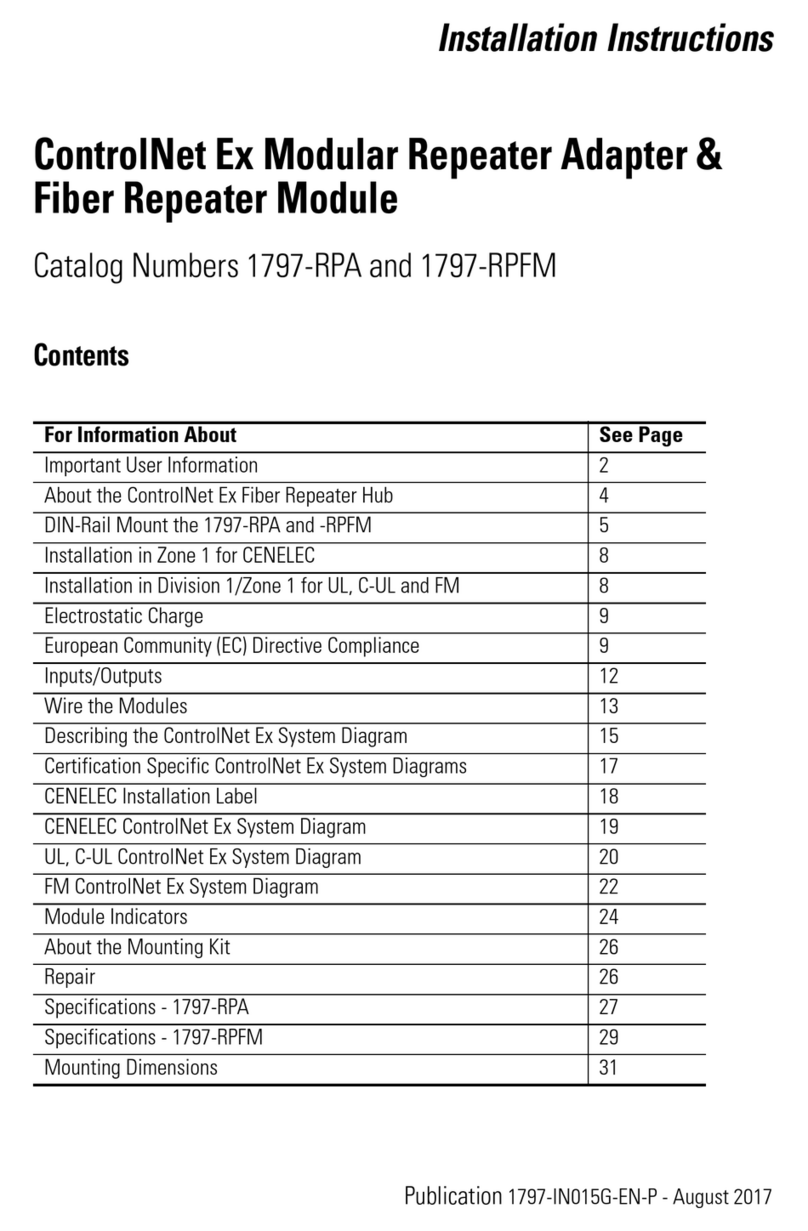
Allen-Bradley
Allen-Bradley ControlNet Ex 1797-RPA installation instructions
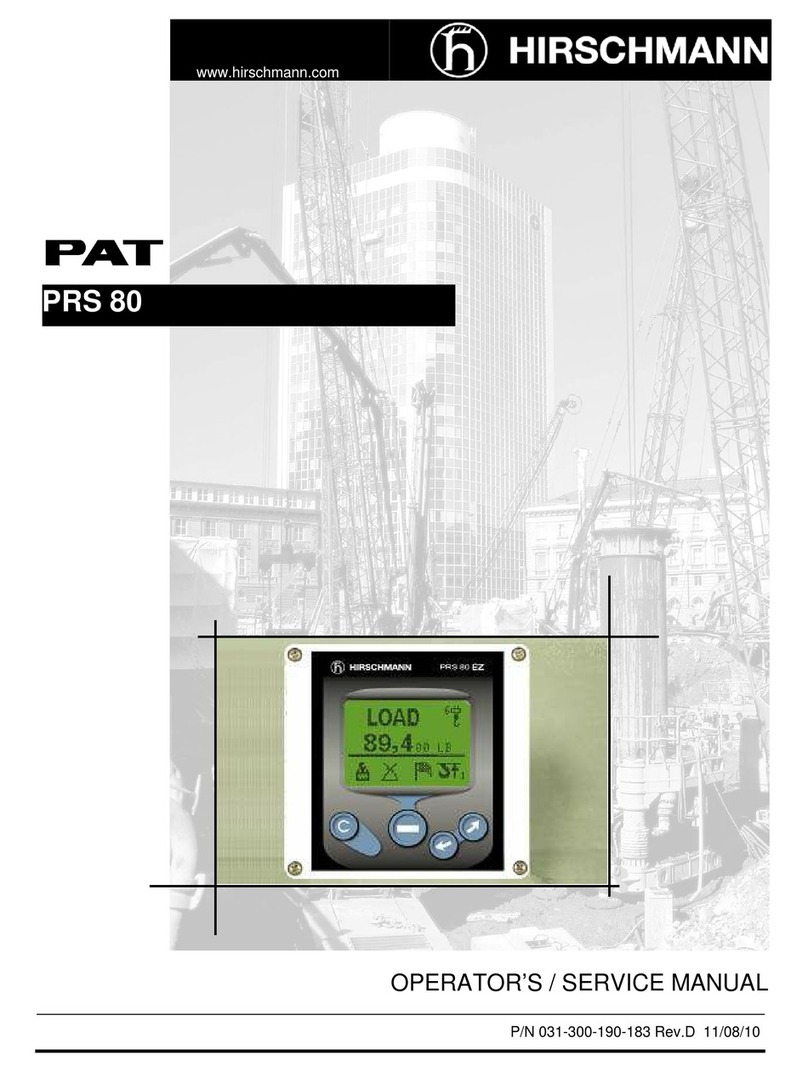
Hirschmann
Hirschmann PRS 80 Operators & service manual

SMC Networks
SMC Networks EX260-SEN2-X205 Operation manual

Simu
Simu veoHz Translation of the original manual
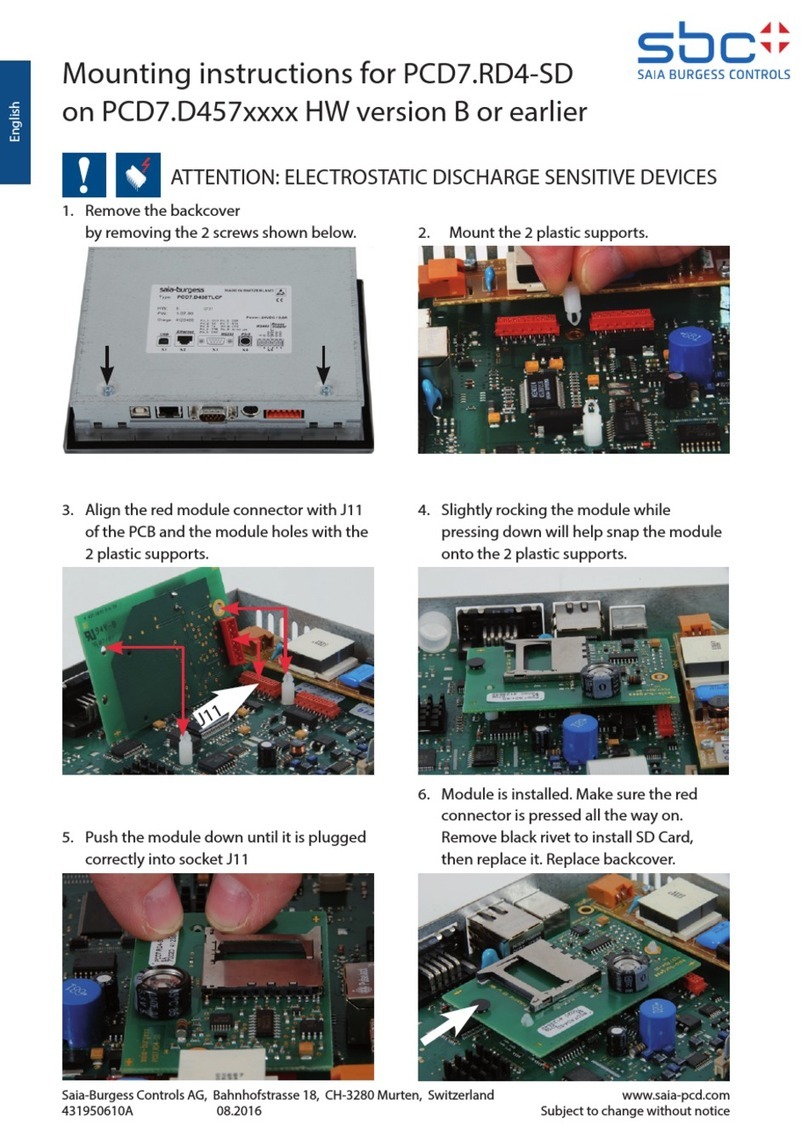
SBC
SBC PCD7.RD4-SD Mounting instructions



